
Working Paper Series
Who gets jobs matters: monetary
policy and the labour market in HANK
and SAM
Uroš Herman, Matija Lozej
Disclaimer: This paper should not be reported as representing the views of the European Central Bank
(ECB). The views expressed are those of the authors and do not necessarily reflect those of the ECB.
No 2850
Abstract
This paper first provides empirical evidence that labour market outcomes for the less ed-
ucated, who also tend to be poorer, are substantially more volatile than labour market
outcomes for the well-educated, who tend to be richer. We estimate job finding rates and
separation rates by educational attainment for several European countries and find that
job finding rates are smaller and separation rates larger at lower educational attainment
levels. At cyclical frequencies, fluctuations of the job finding rate explain up to 80% of
the unemployment fluctuations for the less educated. We then construct a stylised HANK
model augmented with search and matching and ex-ante heterogeneity in terms of ed-
ucational attainment. We show that monetary policy has stronger effects when the job
market for the less educated and hence poorer is more volatile. The reason is that these
workers have the most procyclical income coupled with the highest marginal propensity
to consume. An expansionary monetary policy shock that increases labour demand dis-
proportionally affects the labour market segment for the less educated, causing a strong
increase in their consumption. This further amplifies labour demand and increases labour
income of the poor even more, amplifying the initial effect. The same mechanism carries
over to forward guidance.
JEL classification: E40, E52, J64
Keywords: Heterogeneous agents, Search and matching, Monetary policy, Business cycles, Employ-
ment
ECB Working Paper Series No 2850
1
Non-technical summary
In this paper we first provide a set of new empirical estimates of job finding and separation
rates by educational attainment, and their cyclical properties for several European countries.
We find that job finding rates for the less educated (and more likely poor) workers are lower,
highly procyclical, and more volatile than for the better educated (more likely better well-
off) workers. We also find that separation rates are higher, tend to be more volatile, and
often acyclical for the less educated workers. There are considerable differences across Eu-
ropean countries, with some countries where the labour market displays fewer differences
by educational attainment than in others. In all cases, fluctuations in job finding rates seem
to contribute the most to fluctuations in unemployment of the less educated at cyclical fre-
quencies, with the contribution of job finding rate fluctuations exceeding 80% in countries
like Germany and France. We report similar evidence for the US. In all cases, the evidence
suggests that agents with low educational attainment face higher employment risk over the
business cycle than agents with high educational attainment.
We then build a stylised model with the search and matching framework embedded in
a HANK framework that attempts to capture these empirical properties. The model con-
siders the economy as composed of different labour market segments, where workers can
either stay in the same market segment and face its income risk, or exogenously switch to an-
other labour market segment, with different characteristics regarding wage fluctuations and
(un)employment risk. These exogenous switches between labour market segments are rare
but persistent and can be thought of as persistent changes in the desirability for a particular
skill.
Labour market segments differ with respect to wage level, job finding probabilities, and
their cyclical properties. Each segment functions as a separate labour market with search
and matching frictions. This means that each labour market segment has an endogenous job
finding probability, which depends on firms’ incentives to create vacancies in that segment,
which in turn varies with economic conditions. Cyclical income fluctuations for households
that stay in the same labour market segment occur because search frictions, combined with
wage rigidities, lead to an increased vacancy posting following an expansionary shock, which
increases job finding rates and therefore expected labour income within each labour market
segment. Because the intensity of vacancy posting differs across labour market segments,
the differences between labour market segments change over the business cycle and affect the
idiosyncratic labour income risk for households. In other words, the income loss/gain due to
exogenous shifts from one labour market segment to the other differs over the business cycle.
We use this framework to investigate the implications of such heterogeneous labour mar-
kets for monetary policy. We show that if poor workers obtain relatively more jobs after a
monetary expansion, which is consistent with empirical evidence for most countries we con-
sider, they also spend a larger proportion of the additional income, because their marginal
propensity to consume is higher. This amplifies the aggregate demand increase, which leads
to more labour demand from firms that have to produce in order to meet consumption de-
ECB Working Paper Series No 2850
2
mand. Because the labour market for the poor is more sensitive to the business cycle, this
leads to a relatively stronger increase in employment of poorer households, which again leads
to a stronger increase in consumption. This works as an amplification mechanism that makes
monetary policy more potent.
What turns out to be important for the amplification is the asymmetry of the labour
market, in the sense that the labour market segment of the poor reacts more procyclically
than the labour market segments further to the right of the wealth distribution. We show that
this can be brought about by two mechanisms that amplify vacancy posting in the labour
market segment with lower educational attainment. One such mechanism is a relatively low
and hence more volatile firm surplus from hiring a worker from this labour market segment,
and the other is a higher wage rigidity in the segment. Either or both lead to more volatile
hiring for workers with lower educational attainment.
ECB Working Paper Series No 2850
3

1 Introduction
The distribution of wealth and the riskiness of income matter substantially for macroeco-
nomic fluctuations in the standard heterogeneous agent New Keynesian (HANK) models
(Kaplan et al., 2018). An important issue in the literature has been the so-called earnings het-
erogeneity channel (Auclert, 2019), which has focussed on the incidence of a particular type
of earnings such as interest, dividends, labour income and taxation (Werning (2015), Broer
et al. (2018), and Hagedorn et al. (2018)). There was less emphasis on the incidence of labour
income itself over the business cycle for different households, even though labour income is
typically the most important source of income for the majority of households.
Labour literature tends to find that workers face heterogeneous employment prospects
and, thus, income risk over the business cycle. For example, Elsby et al. (2010) document that
males, younger, less educated workers, and individuals from ethnic minorities experience
steeper rises in unemployment during all recessions. Similarly, Patterson (2023) finds that
earnings of individuals with higher marginal propensities to consume (i.e., young, black,
and poor) are more exposed to recessions.
1
Relatedly, Haltiwanger et al. (2018) document
that during the downturns, less educated and younger workers are more likely to exit to
nonemployment and less likely to get out of nonemployment. Hoynes et al. (2012) come
to a similar conclusion using individual-level Current Population Survey (CPS) and Merged
Outgoing Rotation Group (MORG) data.
2
Workers with such characteristics are more likely
to be poor. For example, in the Households Finance and Consumption Survey, the typical
finding is that younger and less educated households are more likely to be credit constrained
(see HFC (2016)).
Who is rich and who is poor matters in HANK models because households differ in
terms of their marginal propensities to consume. In this setting, it is important whether
household income (and income risk) is pro- or countercyclical because this matters for aggre-
gate demand, which in turn matters for general equilibrium effects on households’ incomes
(Werning (2015), Acharya and Dogra (2018), Bilbiie (2018)). Moreover, economic policies may
affect various segments of the wealth distribution differently, with the left tail typically being
more strongly affected (Amberg et al. (2022) and Broer et al. (2022)). Using administrative
data for the US, Guvenen et al. (2017) investigate how individual earnings vary across the
wealth distribution, and find that the sensitivity of the workers to the business cycle, the
so-called “worker betas”, is higher at the bottom and at the top of the earnings distribution.
Kramer (2022) finds that the sensitivity is substantially higher at the bottom of the earnings
distribution (but not at the top) using German data. Moreover, he can attribute this to the
fluctuations in the extensive margin rather than to wages. Auclert and Rognlie (2018) use
1
Mueller (2017) finds that during recessions, the pool of unemployed shifts towards high-wage workers.
Elsby et al. (2015) observe similar regularity, and they attribute it to compositional effect; during recessions,
the composition of the unemployment pool becomes skewed towards more attached individuals (i.e. male,
prime-aged, more educated) because they are less likely to exit the labour force.
2
Den Haan and Sedlacek (2014) develop a model where the least productive workers lose jobs first during
the recession, and the most productive workers tend to get jobs first during the boom.
ECB Working Paper Series No 2850
4

the results from Guvenen et al. (2017) to calibrate a function that rations labour of partic-
ular groups of households when wages are sticky, but the deeper underlying reasons why
and who gets/loses jobs in the boom/recession have been less thoroughly investigated. A re-
cent example of an approach that provides more micro-foundations for heterogeneous labour
market outcomes has been to use capital-skill complementarities (Dolado et al., 2021).
This paper first provides new empirical evidence on job finding and separation rates by
educational attainment for several European countries, which is novel and of independent
interest. We find that job finding rates for the less educated (and more likely poor) workers
are lower, highly procyclical, and more volatile than for the better educated (more likely
rich) workers. We also find that separation rates are higher, tend to be more volatile, and
often acyclical for less educated workers. There are considerable differences across European
countries, with some countries where the labour market seems more homogeneous (with
fewer differences by educational attainment) than in others. In all cases, fluctuations in job
finding rates contribute most to fluctuations in unemployment of the less educated at cyclical
frequencies, with the contribution of job finding rate fluctuations exceeding 80% in countries
like Germany and France. We report similar evidence for the US. In all cases, the evidence
suggests that agents with low educational attainment face higher employment risk over the
business cycle than agents with high educational attainment.
We then build a stylised model with the search and matching framework embedded in
a HANK framework that attempts to capture the above empirical regularities. The model
considers the economy as composed of different labour market segments, where workers can
either stay in the same market segment and face its income risk, or exogenously switch to
another labour market segment, with different characteristics regarding wage fluctuations
and (un)employment risk. These exogenous switches between labour market segments are
rare but persistent and can be thought of as persistent changes in desirability for a particular
skill.
3
Labour market segments differ with respect to wage level, job finding probabilities,
and their cyclical properties. Each segment functions as a separate labour market with search
and matching frictions. This means that each labour market segment has an endogenous job
finding probability, which depends on firms’ incentives to create vacancies in that segment,
which in turn varies with economic conditions. Cyclical income fluctuations for households
that stay in the same labour market segment occur because search frictions, combined with
wage rigidities, lead to an increased vacancy posting following an expansionary shock, which
increases job finding rates and therefore expected labour income within each labour market
segment. Because the intensity of vacancy posting differs across labour market segments,
the differences between labour market segments change over the business cycle and affect
the idiosyncratic labour income risk for households (the income loss/gain due to exogenous
shifts from one labour market segment to the other).
3
For instance, one can think of one incidence of such a switch looking at the data from a major job finding
intermediary, Indeed (Adrjan (2019)). These indicate that upon the announcement that the plant of British Steel
was scheduled to close, workers from that plant searched for jobs that were below their qualification level. That
is, they searched for a job in what is effectively a different labour market segment.
ECB Working Paper Series No 2850
5
We use this framework to investigate the implications of such heterogeneous labour
markets for monetary policy. We show that if poor workers obtain jobs after a monetary
expansion (which is consistent with empirical evidence), they spend a larger proportion of
the additional income, because their marginal propensity to consume is higher. This amplifies
aggregate demand, which leads to more labour demand from firms that have to produce
in order to meet consumption demand. Because the labour market for the poor is more
sensitive to the business cycle, this leads to a relatively stronger increase in employment of
poorer households, which again leads to a stronger increase in consumption. This works as
an amplification mechanism that makes monetary policy more potent. What turns out to be
important for the amplification is the asymmetry of the labour market, in the sense that the
labour market segment of the poor reacts more procyclically than the labour market segments
further to the right of the wealth distribution. We show that this can be brought about by
two mechanisms that amplify vacancy posting in the labour market segment with lower
educational attainment. One such mechanism is a relatively low and hence more volatile
firm surplus from hiring a worker from this labour market segment, and the other is a higher
wage rigidity in the segment. Either or both lead to more volatile hiring for workers with
lower educational attainment.
Our paper is most closely related to papers analysing economic fluctuations in het-
erogeneous agents models with labour market frictions (see, for example, Den Haan et al.
(2017), Ravn and Sterk (2017)). However, our paper differs from the others in focusing on the
differences between labour market segments and their implications for shock transmission.
Compared to Ravn and Sterk (2016) and Ravn and Sterk (2017), we consider the interplay
between several labour market segments and allow agents to save. Den Haan et al. (2017)
allow agents to save in two assets and solve the model fully globally, but they analyse a
unified labour market. Gornemann et al. (2016) do not differentiate between the structure of
labour market segments and focus mostly on systematic monetary policy and the distribution
of incomes from assets and labour, while our focus is on labour market segments. Kramer
(2022) models the transition between labour market segments as endogenous using directed
search, while our setting, where educational attainment is predetermined, considers switches
between labour markets that require different levels of educational attainment as exogenous
(and slow relative to the business cycle frequency). Differently from Dolado et al. (2021), our
model generates different labour market outcomes by only relying on labour market search
frictions without the need for capital-skill complementarity.
The remainder of the paper is structured as follows. Section 2 presents the empirical
evidence on who obtains jobs and when. Section 3 describes the model, Section 4 discusses
the results, and Section 5 concludes.
ECB Working Paper Series No 2850
6

2 Who gets and who loses jobs
Employment outcomes of the well and less educated workers can differ markedly over the
business cycle. Education level can also serve as a proxy for income and wealth, and the
literature has shown that economic policies may affect households at a different point in the
wealth distribution differently (see, for example, Amberg et al. (2022) or Broer et al. (2022)).
This section provides novel empirical evidence for several European countries and the US
on who gets and who loses jobs at business cycle frequencies across educational attainment
levels, and what are the main driving forces behind it.
Before looking into the driving forces of unemployment fluctuations, it is instructive
to examine the variability of unemployment rates across educational attainment levels for
selected European countries. Table 1 shows that the unemployment rate at the lowest educa-
tional attainment level is much more volatile than the aggregate unemployment rate and the
unemployment rates at higher education levels for all countries considered, indicating that
those with lower educational attainment are much more exposed to business cycle fluctua-
tions. The remainder of this section examines the underlying forces that drive fluctuations
in unemployment rates, focussing on job finding and separation rates and their behaviour at
business cycle frequencies.
Table 1: Variability of unemployment rates over business cycles
Volatility Relative volatility
σ(u
i
) σ(u
i
)/σ(u)
Country Sample Agg. L M H L M H
France 2003Q1-2019Q4 0.35 0.57 0.36 0.28 1.60 1.00 0.80
Germany 2005Q1-2019Q4 0.25 0.36 0.28 0.16 1.41 1.11 0.64
Greece 1998Q1-2019Q4 1.39 1.55 1.60 1.00 1.12 1.15 0.72
Italy 2001Q1-2019Q4 0.47 0.61 0.43 0.35 1.31 0.92 0.75
Spain 1998Q1-2019Q4 1.23 1.57 1.23 0.85 1.27 0.99 0.69
UK 2000Q1-2019Q4 0.37 0.61 0.41 0.25 1.65 1.11 0.66
Notes: The table reports standard deviations of cyclical components of unemployment rates u
i
, and relative
volatilities with respect to the aggregate unemployment rate u , by educational attainment. Agg. = aggregate,
L = Less than primary, primary, and lower secondary education, M = Upper secondary and post-secondary
non-tertiary education, and H = Tertiary education. We end the sample in Q4 2019 to exclude the COVID-19
period.
2.1 Job finding rates and separation rates by educational attainment in
Europe
To estimate job finding rates by educational attainment, we use data on unemployment spell
duration by educational attainment, available in European Union Labour Force Survey (EU–
LFS). In general, we follow the method by Shimer (2012), and its extension by Elsby et al.
(2013). The difference compared to Elsby et al. (2013) is that we have quarterly data on the
ECB Working Paper Series No 2850
7

duration of unemployment, so we can more directly relate outflows from unemployment to
Shimer’s approach (which is based on monthly data).
4
Using the approach in Shimer (2012), the monthly change in unemployment can be
written as follows
u
t+1
− u
t
= u
<1
t+1
− F
t
u
t
, (1)
where u
t
is unemployment at monthly frequency, u
<1
t+1
is the stock of unemployed with un-
employment duration of less than one month, and F
t
u
t
is the flow out of unemployment.
Rearranging and solving for outflow probability F
t
, one obtains:
F
t
= 1 −
u
t+1
− u
<1
t+1
u
t
, (2)
which can be used to get the (monthly) outflow hazard rate f
<1
t
f
<1
t
= −ln
(
1 − F
t
)
. (3)
Following Shimer (2012), we refer to f
t
as the job finding rate and to F
t
as the correspond-
ing job finding probability. The computation of this rate requires monthly data. However, as
pointed out by Elsby et al. (2013), one can use data at lower frequencies, and this may be more
convenient in labour markets that are less fluid than the US labour market, as is typically the
case in Continental Europe. In particular, one can compute
F
<d
t
= 1 −
u
t+d
− u
<d
t+d
u
t
, (4)
where d is the number of months, and compute the (monthly) outflow hazard rate as
f
<d
t
= −ln
1 − F
<d
t
/d. (5)
We follow this approach, using quarterly data on unemployment by educational at-
tainment collected by Eurostat, and EU–LFS data on unemployment duration spells, also by
educational attainment.
5
We do so for d ∈ {3, 6, 12}, and for three levels of educational attain-
ment: (L) Less than primary, primary, and lower secondary education, (M) Upper secondary
and post-secondary non-tertiary, and (H) Tertiary education. We focus on large countries in
Europe. The reason for this is twofold. First, we have relatively few observations for shorter
unemployment spells due to the relatively less fluid labour markets in Continental Europe,
as pointed out by Elsby et al. (2013). Second, the data is quarterly, and we distinguish by edu-
4
As pointed out by Elsby et al. (2013), there could be an issue of duration dependence for data at a lower
frequency, if the labour market is very fluid, so that job finding rates and separation rates are high. However,
they note that this is less of a problem for most Continental European countries, where labour markets tend to
be less vibrant than in the US, and for which Elsby et al. (2013) find no evidence for duration dependence.
5
Data are seasonal, so we first compute 4-quarter moving averages to remove seasonal fluctuations. The
advantage of this over seasonal adjustment of each series is that it preserves additivity, i.e., moving averages of
unemployed by educational attainment add up to the moving average of total unemployed; moving averages of
the employed and unemployed sum to the moving average of the total labour force.
ECB Working Paper Series No 2850
8

cational attainment, which further reduces the sample. This means that for smaller countries
with a relatively small sample of the Labour Force Survey, we have only a few observations,
especially in the group with the highest educational attainment. We focus on d = 3 in the
main text but also report additional estimates for d = 6 and d = 12.
Table 2: Monthly job finding rates
f
<3
f
<6
f
<12
Country Sample L
M H L M H L M H
France 2003Q1-2019Q4 0.043 0.059
0.068 0.044 0.059 0.067 0.042 0.055 0.061
Germany 2005Q1-2019Q4 0.055 0.064 0.063 0.055 0.063 0.064 0.049 0.054 0.057
Greece 1998Q1-2019Q4 0.032 0.026 0.031 0.040 0.033 0.035 0.039 0.035 0.036
Italy 2001Q1-2019Q4 0.054 0.063 0.077 0.054 0.063 0.073 0.045 0.052 0.058
Spain 1998Q1-2019Q4 0.081 0.081 0.089 0.080 0.080 0.087 0.068 0.069 0.075
UK 2000Q1-2019Q4 0.049 0.068 0.077 0.052 0.070 0.079 0.047 0.061 0.066
Notes: The table reports monthly job finding rates f
t
using (5). L = Less than primary, primary, and lower
secondary education, M = Upper secondary and post-secondary non-tertiary education, and H = Tertiary edu-
cation. Values are sample averages. We end the sample in Q4 2019 to exclude the COVID-19 period.
Table 2 reports monthly job finding rates based on our estimates that can be compared
to those in Elsby et al. (2013).
6
Three main results stand out in these estimates. First, there
are considerable differences across countries, with job finding rates ranging from less then
0.03 in Greece to above 0.08 in Spain. Second, the job finding rate rises with educational
attainment and is the highest for those with tertiary education and above (H). However, there
are exceptions, such as Greece and Spain, where the job finding rate does not increase (or
only mildly increases) with the level of educational attainment.
7
Finally, and consistently
with Elsby et al. (2013), we find that duration dependence does not seem to play a role - our
estimates of levels and volatilities are similar for various durations.
With the estimates of job finding rates f
t
, it is possible to back out the corresponding
separation rates s
t
(and the corresponding separation probability S
t
). Shimer (2012) advocates
using the following formula, which accounts for the fact that a worker who loses a job can
find a new one within the same period:
u
t+1
=
1 − e
−
(
f
t
+s
t
)
s
t
f
t
+ s
t
l
t
+ e
−
(
f
t
+s
t
)
u
t
, (6)
where l
t
is labour force and e
t
is employment (and l
t
= e
t
+ u
t
).
8
This equation allows
us to solve for the separation rate implicitly. We apply it to each educational attainment
6
Table 12 in appendix reports quarterly job finding probabilities F
<d
t
that we use in Section 3 to calibrate the
model.
7
This may be due to public-sector employment reductions during the sovereign debt crisis, which might
have affected relatively more educated workers in the public sector, although we cannot verify this based on
our data.
8
Accounting for the possibility that workers can lose and find a job within the period could in principle be
important in our case because of the quarterly data frequency. However, because we find for all countries in our
sample that hazard rates f
t
and s
t
are low (as in Elsby et al. (2013)), this is less of a concern.
ECB Working Paper Series No 2850
9

level, using our estimates of job finding rates by educational attainment and by duration of
unemployment. The results are reported in Table 3.
Table 3: Monthly separation rates
s
<3
s
<6
s
<12
Country Sample L
M H L M H L M H
France 2003Q1-2019Q4 0.007 0.006
0.004 0.007 0.006 0.004 0.007 0.005 0.004
Germany 2005Q1-2019Q4 0.007 0.003 0.002 0.007 0.003 0.002 0.006 0.003 0.001
Greece 1998Q1-2019Q4 0.005 0.006 0.004 0.006 0.007 0.005 0.006 0.007 0.005
Italy 2001Q1-2019Q4 0.007 0.006 0.005 0.007 0.006 0.005 0.006 0.005 0.004
Spain 1998Q1-2019Q4 0.020 0.014 0.010 0.020 0.014 0.010 0.018 0.012 0.008
UK 2000Q1-2019Q4 0.005 0.004 0.003 0.005 0.004 0.003 0.005 0.004 0.002
Notes: The table reports monthly separation rates s
t
using (6). L = Less than primary, primary, and lower
secondary education, M = Upper secondary and post-secondary non-tertiary education, and H = Tertiary edu-
cation. Values are sample averages. We end the sample in Q4 2019 to exclude the COVID-19 period.
Separation rates in Table 3 are higher for lower educational attainments than for higher
educational attainment levels, except in Greece, where the separation rates are relatively
close for all three educational attainment groups. Overall, the evidence from job finding and
separation rates is consistent with the notion that the risk of becoming unemployed, and
not finding a job quickly once unemployed, is higher for workers with lower educational
attainment.
9
2.1.1 Cyclical properties of job finding and separation rates
Further characteristics that are of interest are the volatility and cyclical behaviour of the
estimated job finding and separation rates.
Table 4 reports the standard deviation and correlation of the cyclical components of the
estimated job finding rates with the cyclical component of the total unemployment rate.
10
Three characteristics stand out. First, the job finding rates of the least educated (L) tend
to be more volatile in some countries (France, Germany, the UK) than job finding rates of
those with better education, especially when considering unemployment for each particular
educational attainment level (note that the highest education level, H, is quite volatile mainly
because of very small samples for this segment, so the results should be interpreted with cau-
tion).
11
Second, job finding rates at all educational levels are procyclical (they are negatively
correlated with unemployment). Third, there is considerable heterogeneity across countries
regarding the cyclical properties across educational attainment levels. In Germany, the M and
9
In Appendix A.1, we also plot monthly job finding f
<d
t
and separation rates s
<d
t
by educational attainment
across selected European countries for different unemployment duration spells.
10
Cyclical components were obtained using the Hodrick-Prescott filter with the smoothing coefficient of 1600,
applied to average monthly rates in the quarter, as in Fujita and Ramey (2009).
11
While we do not emphasise this aspect here, job finding rates for the least educated tend to also be highly
seasonal, especially in countries of Southern Europe. This is another indication that this segment of the labour
market features more risky jobs than the other segments.
ECB Working Paper Series No 2850
10

H educational levels are almost acyclical; in Italy, L is mildly procyclical, and M and H are
more procyclical than L. Similarly, procyclicality tends to increase mildly with educational at-
tainment in Spain, while in Greece, all educational levels are similarly procyclical. In France,
Germany, and the UK, lower educational attainment levels tend to be more procyclical.
Table 4: Cyclical properties of job finding rates
Rel.
own v
ol. Rel. aggregate vol. Corr. with agg.
σ( f
i
)/σ(U
i
) σ( f
i
)/σ(U) unemployment
Countr
y Sample L
M H L M H L M H
France
2003Q1-2019Q4 13.93 11.38
14.19 14.96 11.80 19.01 -0.61 -0.43 -0.56
Germany 2005Q1-2019Q4 16.51 12.58 16.03 15.86 13.99 22.98 -0.46 -0.19 -0.08
Greece 1998Q1-2019Q4 8.08 5.92 9.15 7.75 6.37 9.69 -0.39 -0.42 -0.41
Italy 2001Q1-2019Q4 11.38 12.12 16.67 11.83 12.04 19.17 -0.23 -0.41 -0.50
Spain 1998Q1-2019Q4 8.52 10.46 10.84 9.08 9.84 10.84 -0.59 -0.71 -0.80
UK 2000Q1-2019Q4 12.76 12.28 11.21 11.36 13.78 15.40 -0.34 -0.42 -0.26
Notes: The table reports standard deviations of cyclical components of monthly job finding rates relative to the
standard deviation of the cyclical component of each group’s unemployment U
i
, aggregate unemployment U,
and correlations of cyclical components of monthly job finding rates with the cyclical component of aggregate
unemployment, all based on d = 3 estimates. L = Less than primary, primary, and lower secondary education,
M = Upper secondary and post-secondary non-tertiary education, and H = Tertiary education. We end the
sample in Q4 2019 to exclude the COVID-19 period.
The same set of cyclical statistics as for the job finding rates is reported in Table 5 for
separation rates. Several results stand out. First, separation rates are less volatile than job
finding rates relative to all unemployment measures. Second, separation rates for the lowest
educational attainments tend to be much more volatile than those for higher educational
attainment levels. Third, in particular for Germany and France and to a lesser degree for the
UK, separation rates at the lower educational attainment levels are acyclical.
2.1.2 Contributions of job finding and separation rates to unemployment fluctuations
An important question is which rate, the job finding rate or the separation rate, contributes
more to the unemployment rate fluctuations over the business cycle. Following Fujita and
Ramey (2009), we decompose unemployment variability into contributions from the job find-
ing and separation rates.
12
Specifically, Shimer (2012) shows that if the job finding and separa-
tion rates are constant during a period t, then the corresponding equilibrium unemployment
rate can be computed using job finding and separation rates as u
ss
t
= s
t
/(s
t
+ f
t
). If trend
components are denoted by a bar, then the deviations of unemployment from the trend can
be written as
ln
u
ss
t
u
ss
t
= (1 − u
ss
t
)ln
s
t
s
t
− (1 − u
ss
t
)ln
f
t
f
t
!
+ ε
t
, (7)
12
The implicit assumption is that the educational attainment of workers does not change materially at business
cycle frequencies.
ECB Working Paper Series No 2850
11

Table 5: Cyclical properties of separation rates
Rel. own vol. Rel. aggregate vol. Corr. with agg.
σ(s
i
)/σ(U
i
) σ(s
i
)/σ(U) unemployment
Country Sample L M H L M H L M H
France 2003Q1-2019Q4 1.02 0.83 0.29 1.10 0.86 0.39 -0.08 0.06 0.26
Germany 2005Q1-2019Q4 1.47 0.74 0.32 1.41 0.83 0.46 0.01 0.65 0.52
Greece 1998Q1-2019Q4 0.71 0.91 0.58 0.68 0.98 0.52 0.41 0.34 0.21
Italy 2001Q1-2019Q4 0.65 0.51 0.44 0.67 0.51 0.51 0.66 0.69 0.44
Spain 1998Q1-2019Q4 1.27 0.93 0.50 1.36 0.87 0.50 0.82 0.81 0.81
UK 2000Q1-2019Q4 0.81 0.50 0.28 0.72 0.56 0.38 0.23 0.47 0.66
Notes: The table reports standard deviations of cyclical components of monthly separation rates relative to the
standard deviation of the cyclical component of each group’s unemployment U
i
, aggregate unemployment U,
and correlations of cyclical components of monthly separation rates with the cyclical component of aggregate
unemployment, all based on d = 3 estimates. L = Less than primary, primary, and lower secondary education,
M = Upper secondary and post-secondary non-tertiary education, and H = Tertiary education. We end the
sample in Q4 2019 to exclude the COVID-19 period.
where ε
t
is the residual term. The above equation can be more compactly written as
du
ss
t
= du
sr
t
+ du
j f r
t
+ ε
t
, (8)
where du
sr
t
and du
j f r
t
are the contributions of the separation rate and the job finding rate,
respectively. The variance of du
ss
t
is then
Var(du
ss
t
) = Cov(du
ss
t
, du
sr
t
) + Cov(du
ss
t
, du
j f r
t
) + Cov(du
ss
t
, ε
t
). (9)
This can be used to attribute the share of cyclical variation in unemployment rate that
is explained by the cyclical variations of the job finding rate β
j f r
, the cyclical variation of the
separation rate β
sr
, and the cyclical variation of the residual β
ε
:
β
j f r
=
Cov(du
ss
t
, du
j f r
t
)
Var(du
ss
t
)
, β
sr
=
Cov(du
ss
t
, du
sr
t
)
Var(du
ss
t
)
, and β
ε
=
Cov(du
ss
t
, ε
t
)
Var(du
ss
t
)
. (10)
Table 6 reports the estimates of the contributions of the job finding rate and the separa-
tion rate to cyclical fluctuations of unemployment rates (note that β
j f r
+ β
sr
+ β
ε
= 1). The
key finding is that in all countries, fluctuations in the job finding rate are the main contributor
to cyclical fluctuations in the unemployment rate. Moreover, this is overwhelmingly the case
for all countries at the lowest education level, where fluctuations in the job finding rate typi-
cally explain more than half (and often more than 80%) of the fluctuations in unemployment
rates, and more than the share explained by the cyclical fluctuations of the separation rate.
These findings are broadly in line with the empirical evidence for Europe. Slacalek et al.
(2020) suggest that, based on unconditional estimates, the elasticities of employment responses
of hand-to-mouth households, and in particular of poor hand-to-mouth households, tend to
be large. While the estimates vary across countries, the sensitivity of employment of poor
ECB Working Paper Series No 2850
12

Table 6: Contributions to cyclical variation of unemployment
β
j f r
β
sr
Country Sample L M H L M H
France 2003Q1-2019Q4 0.96 0.69 0.92 0.01 0.32 0.07
Germany 2005Q1-2019Q4 0.87 0.48 0.55 0.09 0.49 0.44
Greece 1998Q1-2019Q4 0.39 0.41 0.40 0.19 0.18 0.05
Italy 2001Q1-2019Q4 0.80 0.85 0.86 0.14 0.17 0.10
Spain 1998Q1-2019Q4 0.52 0.60 0.68 0.41 0.35¸ 0.28
UK 2000Q1-2019Q4 0.64 0.64 0.63 0.31 0.33 0.35
Notes: The table reports contributions of the fluctuations of the job finding rate β
j fr
and of the separation rate
β
sr
to cyclical fluctuations of the unemployment rate. All is based on d = 3 estimates. L = Less than primary,
primary, and lower secondary education, M = Upper secondary and post-secondary non-tertiary education, and
H = Tertiary education. β
j fr
and β
sr
do not add up to 1 due to the variance contribution of the residual.
hand-to-mouth households is at least 1.5-times larger than the aggregate employment. A sim-
ilar finding is reported by Dossche and Hartwig (2019), who look at “worker betas” across
the income distribution and find significantly higher worker betas in the lowest household
income quintile. This elasticity can be up to four times higher in the lowest quintile than
in the highest quintile. Kramer (2022) studies the procyclicality of earnings growth in Ger-
many and finds that the procyclicality is mostly driven by transitions from nonemployment
to employment (i.e. job finding rates), especially at the bottom of the income distribution.
Moreover, he finds that individuals at the bottom of the income distribution have lower job
finding rates than wealthy individuals and are more exposed to business cycle fluctuations.
Both findings are in line with what we find for Germany based on the aggregate data. Em-
pirical evidence conditional on a monetary policy shock (Lenza and Slacalek (2018) and Broer
et al. (2022)) also suggests that in Europe, incomes of poor households tend to react more
strongly to a monetary policy than the incomes of wealthier households.
2.2 Evidence from the US
For the US, compared to European countries, we have more detailed data along several di-
mensions. First, we have more granular data in terms of educational attainment level. Second,
data on new hires includes hires from inactivity. Finally, we also have some evidence that
wages at lower educational attainment are more rigid than wages at higher educational at-
tainment levels.
13
The latter will turn out to be important for the quantitative results in the
model.
We use publicly available Longitudinal Employer-Household Dynamics (LEHD) data
from the US Census Bureau. The LEHD database is constructed from various administra-
tive sources, such as Quarterly Census of Employment and Wages, Unemployment Insurance
earnings data, surveys and censuses. All the data we use are quarterly, seasonally adjusted
13
This is the main reason why we report the empirical evidence for the US in a separate subsection.
ECB Working Paper Series No 2850
13
and cover period between 2000Q2 and 2017Q3. If not otherwise stated, (net) hires and sepa-
rations are expressed as a share of employment.
Figures 1a and 1b plot hires from, and separations to, persistent nonemployment across
education groups. One can observe that the hiring rate and separation rate are inversely
related to educational attainment, i.e., less educated workers have larger inflow and outflow
rates to persistent nonemployment.
To get a clearer picture of who is more affected by business cycle fluctuations, we look
at the difference between the two rates. Figure 2 shows net worker flows—hires minus
separations—by educational attainment. It shows that during the recession, net hiring for
the group of workers with the lowest educational attainment declined much more than for
the group with the highest educational attainment; during downturns, the less educated
segments of the labour market experience more adverse developments than segments for the
more educated. This pattern is particularly notable during the Great Recession when the
net hiring for the group with less than high school dropped by more than twice as much as
for the group with the bachelor’s or higher degree. While less extreme, the same pattern is
observed during the milder 2001 recession.
Notably, at the onset of recovery, the net hiring in the groups with the lowest educational
attainment is also the one that exhibits the largest jump upwards. Again the pattern is such
that the upward jumps are more extreme for the less educated groups, and the magnitudes of
the increases decrease with education. This indicates that the groups with lower education,
while being those that are most exposed to the net job loss in the recession, are also the
groups who are the most exposed to net job gain when the recession is over.
Table 7 shows summary statistics for our sample. Less educated workers experience
larger inflow and outflow rates to nonemployment, and these rates are also more volatile.
This confirms that less educated workers face a higher risk of going to, or coming from,
nonemployment. For example, the rate of hires and separations for the workers in the lowest
education group is two to three times larger than for the workers in the highest education
group, and the volatilities of these rates are about three times higher for the least educated
than for the most educated.
With the LEHD data, we, unfortunately, cannot calculate job finding rates, but only their
proxies across education groups. The reason is that a job finding rate is defined as a ratio
of unemployed workers who find a job over the number of unemployed. However, in the
LEHD data, we observe only hires from nonemployment, which is a broader concept than
unemployment, as it also includes workers who are not in the labour force. Nevertheless, we
report these ”rates” (expressed as a share of an average employment within the education
group) in the last row of Table 7, as they at least give some notion of the ranking of these
rates between education groups. Note that these proxies for job finding rates are increasing
with educational attainment (except for the group of less than high school, but this group is
very small in the data).
To further investigate whether workers with low(er) educational attainment face larger
ECB Working Paper Series No 2850
14

Figure 1: Hires and Separations to persistent nonemployment
(a) Hires
.03 .04 .05 .06 .07 .08
Hires from NonE
2000q1 2004q3 2009q1 2013q3 2018q1
date
Less than high school High school or equivalent, no college
Some college or Associate degree Bachelor’s or advanced degree
(b) Separations
.02 .04 .06 .08 .1
Separations to NonE
2000q1 2004q3 2009q1 2013q3 2018q1
date
Less than high school High school or equivalent, no college
Some college or Associate degree Bachelor’s or advanced degree
Notes: A worker is defined as being a Hire from Persistent Nonemployment in quarter t, if she or he had no
main job in the beginning of the quarter t-1 and t, but had one at the end of quarter t. A worker is defined as
undergoing a Separation to Persistent Nonemployment in quarter t, if she or he, had a main job in the beginning
of quarter t, and not at the end of quarter t or quarter t+1. Everything is expressed as a share of an average
employment within the education group. Shaded areas denote NBER recessions.
ECB Working Paper Series No 2850
15
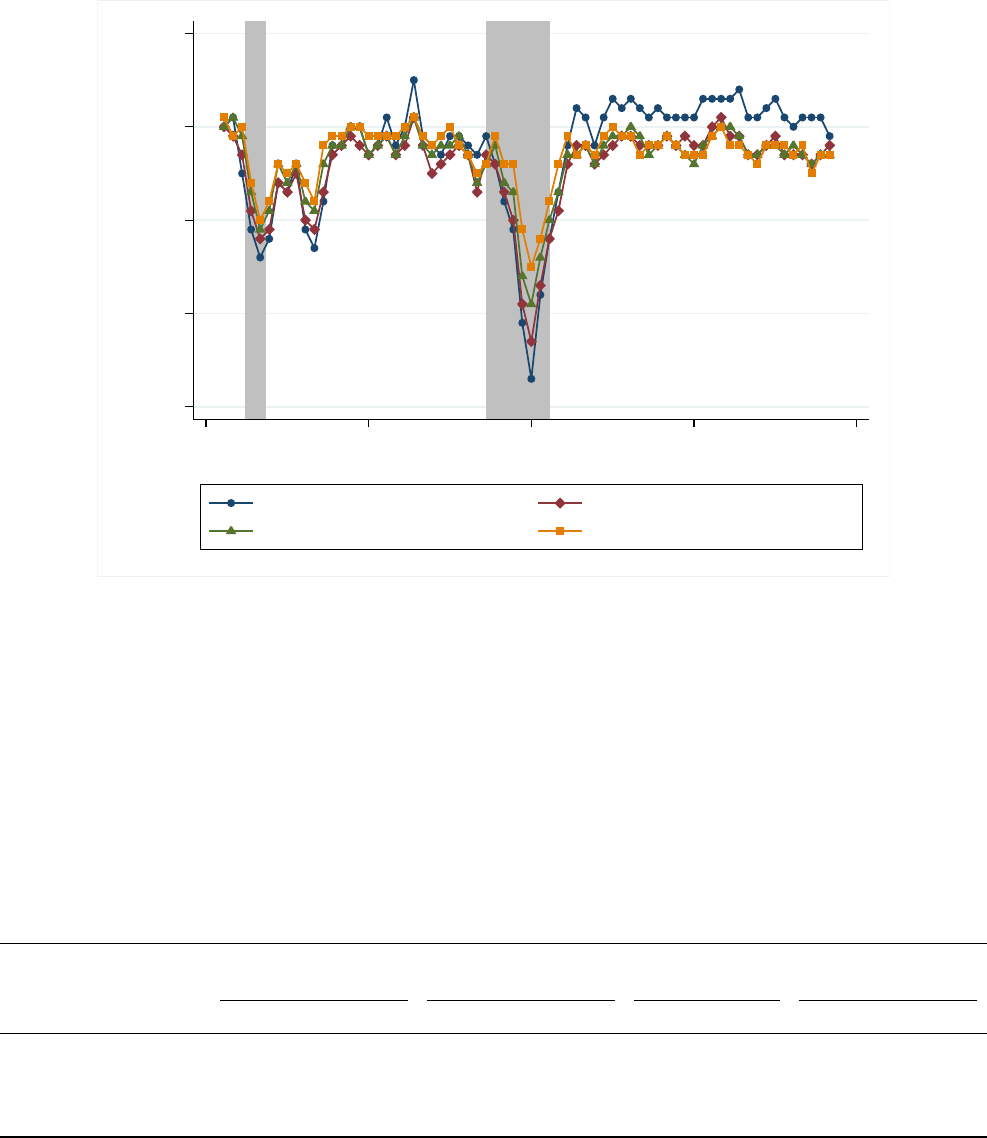
Figure 2: Net hires from persistent nonemployment
-.03 -.02 -.01 0 .01
Hires less Separations to NonE
2000q1 2004q3 2009q1 2013q3 2018q1
date
Less than high school High school or equivalent, no college
Some college or Associate degree Bachelor’s or advanced degree
Notes: Net hires is calculated as the difference between hires from and separations to persistent nonemploy-
ment, and it is expressed as a share of an average employment within the education group. Shaded areas denote
NBER recessions.
Table 7: Summary statistics
High
school or S
ome college or Bachelor’s degree or
Less than high school equivalent, no college Associate degree advanced degree
mean
sd mean sd
mean sd mean sd
Hir
es 0.066 0.0084 0.046
0.0043 0.041 0.0038 0.035 0.0032
Separations 0.069 0.011 0.051 0.0056 0.045 0.0045 0.038 0.0035
Hires less Separations -0.0025 0.0062 -0.0042 0.0045 -0.0035 0.0037 -0.0029 0.0030
Job finding rate proxy 0.782 0.218 0.614 0.187 0.714 0.294 0.776 0.350
Notes: (Net) hires and separations are rates and are expressed as a share of an average employment within the
education group.
ECB Working Paper Series No 2850
16

countercyclical employment risk, we estimate the following equation
Y
i,t
= γ
t
+ β
1
educ
i
+ β
2
educ
i
× X
t
+ ϵ
i,t
, (11)
where Y
i,t
is either the (net) hire or separation rate, X
t
is the cyclical component of GDP,
14
educ
i
is workers’ educational attainment, γ
t
are time dummies to control for common shocks,
and ϵ
i,t
is the residual term. What we are interested in is the coefficient on the interaction
term, which measures the differential responsiveness - across education groups - of net hiring
rate to a business cycle. Note that results have to be interpreted relative to the highest
education group.
15
Table 8: Worker flows over the business cycle
(1)
(2) (3)
VARIABLES Net
hires Hires Separations
Less
than high school 0.000
0.030*** 0.030***
(0.000) (0.001) (0.001)
High school or equivalent, no college -0.001*** 0.011*** 0.012***
(0.000) (0.000) (0.000)
Some college or Associate degree -0.001** 0.006*** 0.007***
(0.000) (0.000) (0.000)
Less than high school × GDP cycle 0.123*** 0.079** -0.018
(0.036) (0.037) (0.056)
High school or equivalent, no college × GDP cycle 0.070*** 0.018 -0.044
(0.024) (0.019) (0.029)
Some college or Associate degree × GDP cycle 0.037 0.003 -0.031
(0.025) (0.020) (0.032)
T
ime FE X X
X
Observations 272 276 276
R-squared 0.9028 0.9713 0.9468
Robust
standard err
ors in parentheses
*** p<0.01, ** p<0.05, * p<0.1
Notes: (Net) hires, and separations are rates and are expressed as a share of an average employment within the
education group.
Table 8 reports the results from estimating Equation 11. Column 1 shows that the net hir-
ing rate of less educated workers is more sensitive to business cycles than the net hiring rate
of workers with the highest level of educational attainment. This implies that (countercycli-
cal) employment risk is the largest for the least educated workers, and it falls with increasing
educational attainment. Results are in line with Haltiwanger et al. (2018), who find that
during recessions, workers with lower education are more likely to exit to nonemployment.
They also find that conditional on firm productivity groups, hires and separations are more
cyclically sensitive for less educated workers. In columns 2 and 3, we separate the net hiring
14
We obtain it after applying the Hodrick-Prescott filter to a logarithm of seasonally adjusted real GDP. In
Appendix B.2, we also consider other business cycle measures, i.e. NBER recession episodes and the cyclical
component of the level of unemployment. The results do not materially change.
15
That is, relative to workers with a bachelor’s degree or an advanced degree.
ECB Working Paper Series No 2850
17

rate into hires and separations to see which margin is more important. We find that only
hires are significantly different across education levels; the hiring rate for the least educated
workers is more cyclically sensitive than for the workers with the highest education.
16
In
Appendix Table 18, we also estimate the sensitivity of changes in (net) hires and separation
rates to changes in GDP across education groups. Results confirm our previous findings that
changes in (net) hiring rates of workers with lower education tend to be more sensitive to
changes in GDP, implying that they face larger employment and, therefore, income risk than
more educated workers.
2.2.1 Wage rigidity
For the US, we also have some evidence of differential wage rigidity across educational at-
tainment levels, which we lack for European countries.
Figure 3 plots the data from the matched Current Population Survey dataset (see Daly
et al. (2012)). The figure shows the percentage of workers who reported no change in their
wages over the past year by educational attainment. It shows that wages of less educated
workers tend to be stickier than wages of more educated workers. This regularity holds over
all business cycle phases and over a long time span.
17
While these data do not cover new
hires, they indicate that labour market segments by educational attainment have different
properties. More recent evidence of differential wage rigidity for new hires across education
levels is Doniger (2019), who finds (i) wages for new hires of least educated workers to
be acyclical, and that (ii) wage (pro)cyclicality increases with the educational attainment.
She also finds that after a monetary policy shock, less educated workers respond on the
employment margin while the more educated respond on the wage margin.
18
3 Model
To capture the characteristics of labour market segments described above and to investigate
their influence on the effectiveness of monetary policy, we build a small stylised model.
The core of the model is the heterogeneous agents New Keynesian model of McKay and
Reis (2016) and McKay et al. (2016), which we augment with search frictions on the labour
market. To account for the different labour market prospects faced by individual households,
we model each labour income level as its own labour market segment.
We assume that each labour market segment is populated by a continuum of households
and a continuum of labour firms. Labour firms post vacancies and households decide how
16
Interestingly, when we run regression on NBER recession episodes (see Table 16 in Appendix B.2), we find
a statistically significant difference in separation rates among education groups; low educated workers have
larger separation rates during downturn(s) relative to highly educated workers.
17
See Figure 31 in Appendix B.1 for the full sample.
18
In contrast, Haefke et al. (2013) and Kudlyak (2014) find no evidence of nominal wage rigidity for new
hires, however as pointed out by Doniger (2019), they investigate a representative agent setting and do not
differentiate across educational attainment.
ECB Working Paper Series No 2850
18
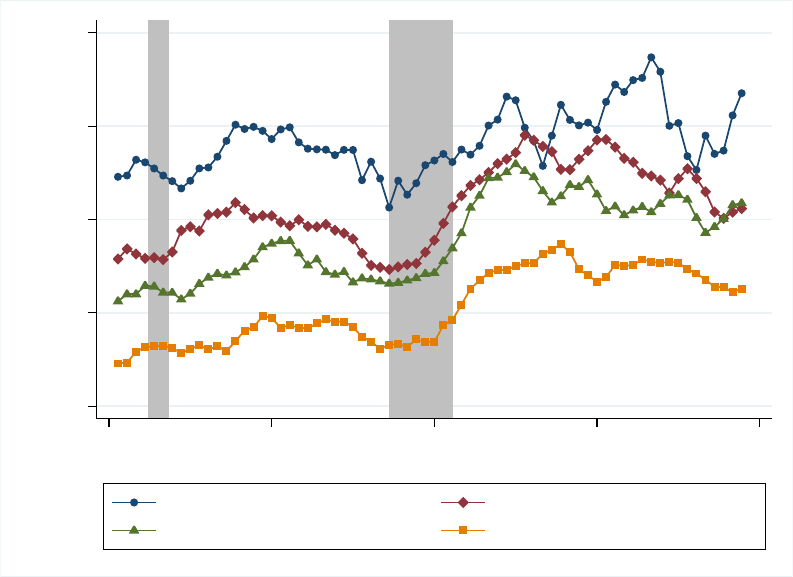
Figure 3: Wage rigidity by educational attainment
5 10 15 20 25
Nominal wage rigidity
2000q1 2004q3 2009q1 2013q3 2018q1
date
Less than high school High school or equivalent, no college
Some college or Associate degree Bachelor’s or advanced degree
Notes: Percentage of workers who saw no change in their wage over the past year by educational attainment.
Source: https://www.frbsf.org/economic-research/indicators-data/nominal-wage-rigidity/
many workers to send searching for jobs. Job search is subject to search frictions, and firms
and households take matching probabilities as given when deciding on how many vacancies
to post or how many workers to send to the market.
Markets are incomplete, and there is heterogeneity between households, but full insur-
ance within each household. Each household consists of a continuum of workers who have
the same level of labour productivity (educational attainment) and can be either employed or
unemployed. At the end of each period, workers bring their incomes home and the house-
hold as a whole decides on how much to consume and save, subject to prices and job finding
probabilities. This simplification allows us that, within a household type, we can use the av-
erage rates of employment, unemployment, matching probabilities, and wages. In addition,
if there are no unemployment benefits available, this assumption also prevents households
with no assets from having zero consumption. Note that this assumption still preserves the
cyclical risk of household income as a whole.
The household sends its workers to search for work at the beginning of each period.
They either find work, in which case they bring home earnings, or they remain unemployed
and receive unemployment benefits (if any). At the end of the period, all jobs terminate, and
the search starts again in the next period. This assumption allows us to avoid an additional
state variable (employment) for each labour market segment. Because we have three labour
market segments, this would add three additional endogenous state variables to the already
existing one endogenous continuous variable (asset holdings) and one exogenous (labour
ECB Working Paper Series No 2850
19

productivity process). Note that even in this case, the persistence of employment is implied
by the job finding probability in the labour market segment. That is, in segments with higher
job finding probabilities, employed workers are more likely to remain employed, even if they
separate every period, because they are more likely to find a new job at the beginning of the
next period. That is, we can mimic income risk (and its fluctuations) in each labour market
segment by the level and fluctuations of the job finding probability.
The remainder of the model is similar to McKay et al. (2016). In the main text, we only
report the equations related to the search and matching frictions on the labour market in the
model, while the remaining equations are reported in Appendix C. The economy is populated
by a continuum of ex-ante identical households who face the following decision problem:
V
t
(b
h,t
, z
h,t
) = max
c
h,t
,b
h,t+1
,s
h,t
,l
h,t
,u
h,t
c
1−γ
h,t
1 − γ
− η
1
s
1+η
2
h,t
1 + η
2
+ β
∑
z
h,t+1
P
(
z
h,t+1
|z
h,t
)
V
t+1
(b
h,t+1
, z
h,t+1
)
subject to
c
h,t
+
b
h,t+1
1 + r
t
= b
h,t
+ Bu
h,t
+ w
h,t
l
h,t
− τ
z
h
,t
+ Π
z
h
,t
, (12)
s
h,t
= l
h,t
+ u
h,t
, (13)
l
h,t
= p
W
z
h
,t
s
h,t
, (14)
u
h,t
= (1 − p
W
z
h
,t
)s
h,t
, (15)
and
b
h,t+1
≥ 0. (16)
Here, c
h,t
is consumption of household with the educational attainment h at time t, b
h,t
are
its bond holdings at time t, r
t
is the real interest rate, s
h,t
is the number of searching workers
within household h at time t, l
h,t
is the number of employed workers within household h at
time t, u
h,t
is the number of unemployed workers within household h at time t, w
h,t
is the
real wage, and B are unemployment benefits. τ
z
h
,t
are taxes (levied as lump-sum depending
on the household’s labour endowment, and Π
z
h
,t
are profits from intermediate goods firms
and labour firms.
19
P
(
z
h,t+1
|z
h,t
)
is the (exogenous) probability of transitioning between
labour market segments, and it follows a Markov process. The households take prices, taxes,
dividends, and unemployment benefits as given.
We assume that all intermediate goods firms are held by an investment fund managed by
a risk-neutral manager, who collects profits and distributes them as dividends to households
(households cannot trade in equities). Households are allowed to save by holding and trading
19
We assume that profits from labour firms are given back to households as lump-sum but in proportion to
employment.
ECB Working Paper Series No 2850
20

riskless real bonds issued by the government. These bonds are in positive and constant net
supply, so households can partially self-insure by saving.
A household’s optimisation gives the following first-order conditions with respect to the
choice variables
c
h,t
−γ
− λ
h,t
= 0, (17)
−
c
h,t
−γ
1 + r
t
+ β
∑
z
h,t+1
P
(
z
h,t+1
|z
h,t
)
V
′
t+1
(b
h,t+1
, z
h,t+1
) = 0, (18)
−η
1
s
η
2
h,t
+ p
W
h,t
q
h,t
− µ
h,t
+ (1 − p
W
h,t
)ξ
h,t
= 0, (19)
−q
h,t
+ µ
h,t
+ λ
h,t
w
h,t
= 0, (20)
−ξ
h,t
+ µ
h,t
+ λ
h,t
B = 0, (21)
where λ
h,t
is the multiplier on (12), µ
h,t
on (13), q
h,t
on (14), and ξ
h,t
on (15).
By eliminating the Lagrange multiplier on the budget constraint and applying the enve-
lope theorem, we get the standard Euler equation
c
h,t
−γ
= β(1 + r
t
)
∑
z
h,t+1
P
(
z
h,t+1
|z
h,t
)
(c
h,t+1
−γ
). (22)
3.1 Labour market
Labour market segments. There is a separate labour market for each productivity type
of households (in total, there are three labour market segments). On each labour market
segment, indexed by the productivity type z
h
, we have a separate matching function and
matching probabilities:
m
z
h
,t
= ϕ
z
h
s
µ
z
h
z
h
,t
v
1−µ
z
h
z
h
,t
, (23)
where m
z
h
,t
is the number of matches in the market z
h
, ϕ
z
h
is the labour-market-segment-
specific matching efficiency, s
z
h
,t
is the number of searching workers, and v
z
h
,t
is the number
of vacancies. µ
z
h
is the elasticity of the matching function with respect to the number of
searching workers.
The matching probability for the worker, p
W
z
h
,t
, is
p
W
z
h
,t
=
m
z
h
,t
s
z
h
,t
= ϕ
z
h
v
z
h
,t
s
z
h
,t
1−µ
z
h
= ϕ
z
h
(
θ
z
h
,t
)
1−µ
z
h
, (24)
and the matching probability for the firm, p
F
z
h
,t
, is
ECB Working Paper Series No 2850
21

p
F
z
h
,t
=
m
z
h
,t
v
z
h
,t
= ϕ
z
h
v
z
h
,t
s
z
h
,t
−µ
z
h
= ϕ
z
h
(
θ
z
h
,t
)
−µ
z
h
. (25)
Households’ labour supply. Households send workers to search until the cost of searching
(measured in monetary terms) is equal to the expected earnings from searching. Rearranging
(17), (19), (20) and (21) delivers
η
1
(l
h,t
+ u
h,t
)
η
2
c
−γ
h,t
= p
W
h,t
w
h,t
+ (1 − p
W
h,t
)B, (26)
where (l
h,t
+ u
h,t
) ≡ s
h,t
is the total amount of workers the household sends in the beginning
of the period to the labour market to search for jobs, c
−γ
h,t
is the marginal utility of consump-
tion, p
W
z
h
,t
is a fraction of workers who find a job and earn real wage w
z
h
,t
, and (1 − p
W
z
h
,t
) is a
fraction of workers who do not find a job, but receive unemployment benefits B. Condition
26 says that in equilibrium, the disutility of searching (measured in monetary terms) has to
be equal to the expected earnings from searching. The latter are weighted average of the ex-
pected real wage and unemployment benefits, where the weight is the probability of getting
a job.
20
The setting of the model makes it clear where the sources of income fluctuations come
from. The first source, which is due to idiosyncratic labour productivity shocks that shift
households between labour market segments, is acyclical. These shocks can be thought of as
shocks that make a particular skill either more sought-after or less desired on the market.
21
This type of risk is fully taken into account by the households in our model. The second
type of income fluctuation in our model is cyclical and comes from different labour market
conditions in labour market segments. These conditions depend on the state of the business
cycle and, in our model differ across the labour market segments. Because of these differ-
ences, transition from one labour market segment to the other implies a different gain or loss
of income, depending on the state of the business cycle.
Labour firms. We assume that each productivity segment of the labour market is populated
by a continuum of its own labour firms. Labour firms hire workers and sell their effective
labour as a homogeneous good at a competitive aggregate wage ω
t
to the intermediate-goods
firms. Each labour firm employs one worker. The value function of the labour firm is
J
z
h
,t
= ω
t
z
h,t
− w
z
h
,t
, (27)
where ω
t
z
h,t
is the total revenue received by the labour firm from selling labour services (one
worker provides labour services corresponding to his productivity z
h,t
, which is sold to the
20
Equation (26) also nests standard labour supply model; if p
W
z
h
,t
= 1, so that everyone finds a job (implying
u
h,t
= 0), and B = 0, it reduces to the standard labour supply condition.
21
For example, automation in some industries have made workers with skills that can be automated less
sought-after, and workers who can program the machinery used for automation of these jobs more sought-after.
ECB Working Paper Series No 2850
22

intermediate-goods firm at the rate ω
t
). The labour firm pays the worker real wage w
z
h
,t
and
returns profits to the household as lump-sum.
The free-entry condition for labour firms is
ψ
z
h
= p
F
z
h
,t
J
z
h
,t
, (28)
where ψ
z
h
is the per-period vacancy posting cost in the labour market segment with produc-
tivity z
h
. In equilibrium, the labour firm’s optimality condition states that the per-period cost
of posting a vacancy is equal to the probability that the firm will find a worker, times the
value of that worker for the firm, which is equal to the profit the firm will earn in this period.
Wage determination. We consider two settings for wage determination. When wages are
fully flexible, we assume that the wage rate that is paid to the workers in each segment is
a fraction (1 − α
z
h
) of the aggregate wage cost (which is the revenue received by the labour
firm),
w
z
h
,t
= (1 − α
z
h
)ω
t
z
h,t
. (29)
The aggregate wage cost is determined in equilibrium as the cost that equates the labour
demand from intermediate goods firms with the labour services’ supply from labour firms.
When we analyse a setting with rigid wages, we follow Hall (2005) and model wage
rigidity as a weighted average of the wage that would be determined in the current period
(as described above), and a wage norm. For the wage norm we take the steady-state wage.
22
We allow wage rigidity to differ across labour market segments. The rigid wage is then
w
z
h
,t
= [(1 − ω
R
)(1 − α
z
h
)ω
t
+ ω
R
(1 − α
z
h
)ω]z
h,t
, (30)
where ω
R
∈ [0, 1] is the weight of the wage norm in wage determination, and (1 − α
z
h
)ω is
the wage norm.
Relation to Nash bargaining. Here we show that our flexible wage rule is just a particular
case of the standard Nash bargaining. With Nash bargaining, the wage is the outcome of
bargaining between workers and firms regarding the split of the total surplus generated by a
successful match. The solution to the Nash bargaining problem is
χ
z
h
J
z
h
,t
= (1 − χ
z
h
)(W
E
z
h
,t
− W
N
z
h
,t
), (31)
where χ
z
h
∈ (0, 1), is the bargaining power of the worker that can be labour-market-segment-
specific,
23
J
z
h
,t
is the value of a job for a firm, and W
E
z
h
,t
, W
U
z
h
,t
are the value functions of being
employed and unemployed. The value functions for a firm and a worker are
22
This allows us to avoid introducing past wage as an additional state variable.
23
With χ
z
h
= 1, firms would have zero profits (all the surplus goes to workers), but would still have to pay
positive vacancy posting costs which would prevent them from posting any vacancies.
ECB Working Paper Series No 2850
23

J
z
h
,t
= ω
t
z
h,t
− w
z
h
,t
, (32)
W
E
z
h
,t
= w
z
h
,t
− η
1
(l
h,t
+ u
h,t
)
η
2
c
−γ
h,t
, (33)
W
U
z
h
,t
= B − η
1
(l
h,t
+ u
h,t
)
η
2
c
−γ
h,t
. (34)
To get the wage equation, one substitutes (32), (33), and (34) into (31) yielding
w
z
h
,t
= χ
z
h
(ω
t
z
h,t
− B) + B, (35)
which means that the bargained wage a worker receives is equal to the outside option (in
our case unemployment benefits) and a fraction (χ
z
h
) of the surplus from a successful match.
Note that the larger the χ
z
h
, i.e. the larger the bargaining power of the worker, less “sticky”
is the real wage. If we set B = 0, so that there are no unemployment benefits, and define
χ
z
h
≡ (1 − α
z
h
), we get exactly (29).
Finally, in order to see how the wage depends on the labour market developments, we
substitute (28) and (25), together with (33), and (34) into (31) to obtain
w
z
h
,t
=
χ
z
h
1 − χ
z
h
ψ
z
h
ϕ
z
h
(θ
z
h
,t
)
µ
z
h
+ B, (36)
which states that the negotiated wage is increasing in bargaining power of the worker χ
z
h
,
vacancy posting cost (ψ
z
h
), labour market tightness θ
z
h
,t
, and decreasing in matching efficiency
ϕ
z
h
.
3.2 Calibration
The model is quite stylised and we largely rely on standard values from the literature to
calibrate it. However, for the labour market, we do match some of the properties reported in
the empirical section of the paper. In particular, we calibrate the model to match job finding
probabilities by educational attainment and their relative volatility. We also perform several
experiments illustrating how the model properties depend on the calibration choices.
The calibration of production and utility functions follows McKay et al. (2016), and is
reported in Table 9.
Idiosyncratic risk of transiting from one labour market segment to the other is calibrated
using the transition matrix from McKay et al. (2016) who use the persistent component of
wage process from Floden and Lind
´
e (2001), approximated using a 3-state Markov process
with the transition matrix P:
ECB Working Paper Series No 2850
24

Table 9: Utility function and production function
Parameter Value
Risk aversion γ 2
Frisch elasticity (inverse) η
2
2
Disutility weight for labour η
1
1
Markup µ 1.2
Price rigidity θ 0.15
P =
0.966 0.034 0
0.017 0.966 0.017
0 0.034 0.966
This matrix gives rise to the population shares [0.25 0.5 0.25], for each labour market
segment, ”poor”, ”middle”, and ”rich”. These transition probabilities do not vary over the
business cycle so that the mass of households in each segment is constant.
The calibration of the labour market is reported in Table 10. Labour endowment corre-
sponds to the level of wages in each labour market segment and follows McKay et al. (2016).
The differences in wage level also give rise to differences in the wealth distribution, which
reflects, to some extent, the differences in the wage level (hence the labels ”poor”, ”mid-
dle”, and ”rich”). The calibration of matching elasticities relies on the standard values from
Petrongolo and Pissarides (2001). Since wages in Continental Europe and in Germany are
fairly rigid, and since we do not have good data on the differences in the wage rigidity by
educational attainment levels, we assume that the degree of wage rigidity is equal across
all labour market segments.
24
We investigate the implications of this assumption when we
recalibrate the model to US data.
We use the calibration of the entrepreneur’s share and the vacancy posting cost to match
the job finding probability for the typical case where this probability increases by educational
attainment. We have picked the values that very closely correspond to the values found for
Germany. The model is quarterly, and we report quarterly probabilities corresponding to the
monthly rates from Section 2 in Table 12 in the appendix. Because the job finding probability
depends on the ratio of vacancy posting cost and the entrepreneur’s share, we could have
fixed one and used the other to match the job finding probability. However, we wanted also
to match the relative volatility of the labour market segments, which in Germany are more
volatile and much more procyclical for the low-educated (see Table 14 in the appendix). To do
so, we follow the idea in Hagedorn and Manovskii (2008), who propose to solve the puzzle of
low volatility of labour market variables in the standard search-and-matching model (Shimer,
2005) by calibrating the entrepreneur’s share to be small. We set the entrepreneur’s share to
be smaller in the labour market segment with the lowest educational attainment, where we
24
Our choice of wage rigidity calibration implies that wages adjust only by half of what they would if they
were flexible.
ECB Working Paper Series No 2850
25

observe higher labour market volatility, and then adjust the vacancy posting cost to match
the job finding probability.
Table 10: Matching function and labour firms
Parameter Poor Middle Rich
Labour endowment z
h
0.4923 1.0000 2.0313
Matching elasticity µ
z
h
0.5 0.5 0.5
Matching efficiency ϕ
z
h
0.6 0.6 0.6
Vacancy posting cost ψ
z
h
0.01 0.11 0.37
Entrepreneur’s share α
z
h
0.01 0.06 0.11
Wage rigidity ω
R
0.5 0.5 0.5
Job finding probability p
W
0.14 0.16 0.18
While modelled on Germany, this calibration is meant to represent the typical case found
in the labour data also for other European countries, such as France. We refer to this cali-
bration as ”Poor more volatile”. There are, however, countries such as Spain where there
seem to be fewer differences in terms of volatility and cyclicality between different labour
market segments (Table 14 in the appendix). To illustrate the difference this makes, we also
report simulations for the recalibrated model, where labour market segments are similar in
terms of their volatilities. We do this by matching job finding probabilities for Spain (0.20 for
each labour market segment) and by equalising entrepreneurs’ share across labour market
segments (at 0.05), which makes labour firms’ surplus and hence vacancy posting equally
cyclical for all segments of the labour market. We refer to this calibration as ”All equally
volatile”. Finally, as a counterfactual, we also simulate a calibration where we still keep the
volatility of the labour market outcomes of the less educated higher than that for the highly-
educated, but we make the difference less pronounced. We refer to this case as ”Poor less
volatile”.
4 Results
4.1 Calibration for European countries
We first simulate a standard monetary policy shock, where the central bank temporarily
lowers the real interest rate by half a percentage point.
25
The results are reported in Figures
4 to 6.
25
We follow McKay et al. (2016) and assume that because prices are sticky, a central bank can directly control
the real interest rate in the short run. We use a persistence of 0.6 for the AR(1) process governing the shock.
ECB Working Paper Series No 2850
26
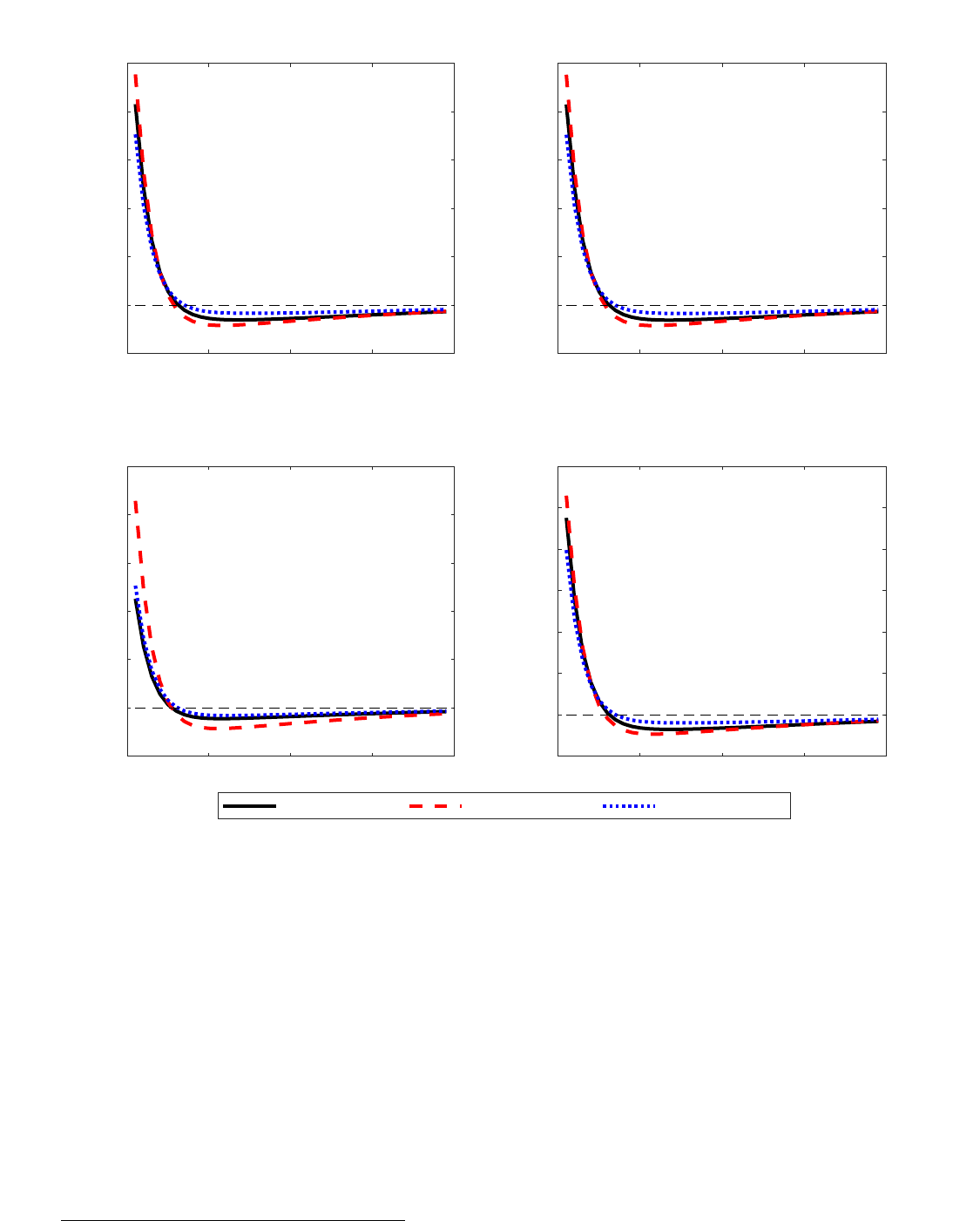
Figure 4: Effectiveness of monetary policy depending on who gets jobs
0 10 20 30 40
-0.1
0
0.1
0.2
0.3
0.4
0.5
Output (Consumption)
0 10 20 30 40
-0.1
0
0.1
0.2
0.3
0.4
0.5
Labour
0 10 20 30 40
-0.05
0
0.05
0.1
0.15
0.2
0.25
Dividends
0 10 20 30 40
-0.1
0
0.1
0.2
0.3
0.4
0.5
0.6
Total labour income (pre-tax)
Poor less volatile Poor more volatile All equally volatile
Notes: All variables are reported in percent deviations from the steady state. Units on the horizontal
axis are quarters.
Figure 4 reports results for the aggregates. The red dashed line represents our bench-
mark calibration in Table 10, where the labour market segment for the less educated house-
holds is calibrated to be more volatile than the other labour market segments, in line with
the data for Germany. For comparison, the full black line shows the case where the labour
market outcomes for the less educated are only half as volatile as the benchmark case (but
still more volatile than the other two labour market segments).
26
Everything else is kept the
same, which allows us to discuss the implications of labour market volatility for aggregate
fluctuations. Finally, we also plot a case where the volatility of labour market outcomes is
26
For this specification, entrepreneur’s shares α
z
h
in Table 10 now read [0.02, 0.06, 0.11].
ECB Working Paper Series No 2850
27

similar across all labour market segments, which would correspond to countries like Spain
(shown as a dotted blue line).
The key property to note is that aggregate fluctuations tend to be amplified when the
labour market segment of the poor is more volatile. The initial output response is, for in-
stance, 17% higher for the red dashed line compared to the full black line, and this is similar
for aggregate labour and labour income responses. The difference in the magnitude of re-
sponses are even larger when compared to the symmetric case. Dividends are procyclical
due to sticky wages.
27
To understand the mechanism behind these results, it is instructive to look at the dis-
aggregated quantities. Figures 5 and 6 report impulse responses of the main variables of
interest by labour market segments. First, note in Figure 5 that labour of the poor households
increases substantially in the benchmark case with the labour market outcomes of the poor
more volatile, while labour of the rich households only increases on impact and then falls.
This becomes less pronounced if we make the labour market for the poor is less procyclical.
At the same time, consumption of the poor increases markedly in the benchmark case and
follows the pattern of the labour responses if we reduce the volatility in the labour market
segment for the poor. Consumption of the rich is almost unaffected, as they can smooth
their consumption by changing their asset holdings. Wages respond symmetrically across
all labour market segments, but with the different magnitude for each case considered, be-
cause they are determined by the aggregate labour demand and labour supply (recall that
the calibrated wage rigidity is the same in all cases shown).
Figure 6 provides an explanation for these observations. When the labour market of
the poor is more volatile, firms post relatively more vacancies in this labour market segment
during the expansion. This is because labour firm profits in this segment are small, in line
with Hagedorn and Manovskii (2008), so they increase by more in percentage terms after a
positive shock whenever there is some wage rigidity. With more vacancies labour market
tightness in the segment increases, and with it also the job finding probability, causing more
employment and more labour income for the poor. Households in this labour market segment
have a high marginal propensity to consume, which is why their consumption increases
strongly. Despite the fact that this labour market segment is small and that consumption of
households in this segment is also small, the increase in consumption is sufficient to increase
aggregate demand, which in turn leads to more labour demand and again more hiring from
the poor labour market segment, leading to further amplification.
More employment in the poor labour market segment, in part, crowds-out employment
in the rich labour market segment, which is why we see a decline in labour in that segment
for the benchmark case. Note that this is not because firms would not want to hire from this
segment (tightness still increases) but because wages and the matching probability in this
27
In our model, all dividends are given as lump-sum to the rich households, who can smooth consumption,
so that cyclical properties of dividends do not play an important role. Note that because dividend income is also
procyclical, it matters less if we distribute it equally. This is in contrast to McKay et al. (2016), where households
that receive a substantial proportion of their income in the form of countercyclical dividends can even see their
total income fall after a monetary expansion.
ECB Working Paper Series No 2850
28
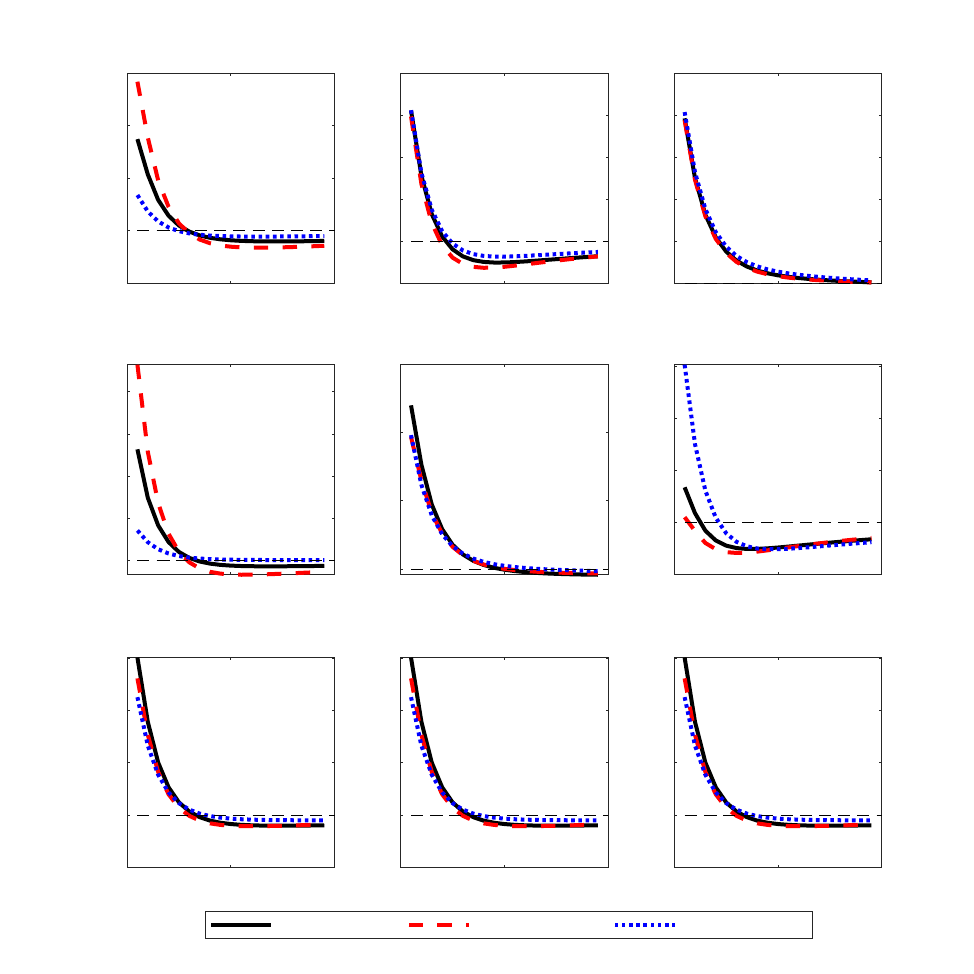
segment do not rise enough to induce the richer households to supply more labour. When
labour market segments are similar in terms of their cyclical behaviour, as is the case for
Spain-like calibration (dotted blue lines), there is little crowding-out on the labour market by
the poor households, which leads to a lower income and consumption response. The same
mechanisms apply to the transmission of forward guidance, reported in Appendix D.
Figure 5: Effectiveness of monetary policy by groups (1)
0 10 20
-0.5
0
0.5
1
1.5
Consumption
Poor
0 10 20
-0.1
0
0.1
0.2
0.3
0.4
Middle
0 10 20
0
0.1
0.2
0.3
0.4
0.5
Rich
0 10 20
0
0.5
1
1.5
2
Labour
0 10 20
0
0.2
0.4
0.6
0 10 20
-0.1
0
0.1
0.2
0.3
0 10 20
-0.01
0
0.01
0.02
0.03
Wages
0 10 20
-0.01
0
0.01
0.02
0.03
0 10 20
-0.01
0
0.01
0.02
0.03
Poor less volatile Poor more volatile All equally volatile
Notes: All variables are reported in percent deviations from the steady state. Units on the horizontal
axis are quarters.
ECB Working Paper Series No 2850
29
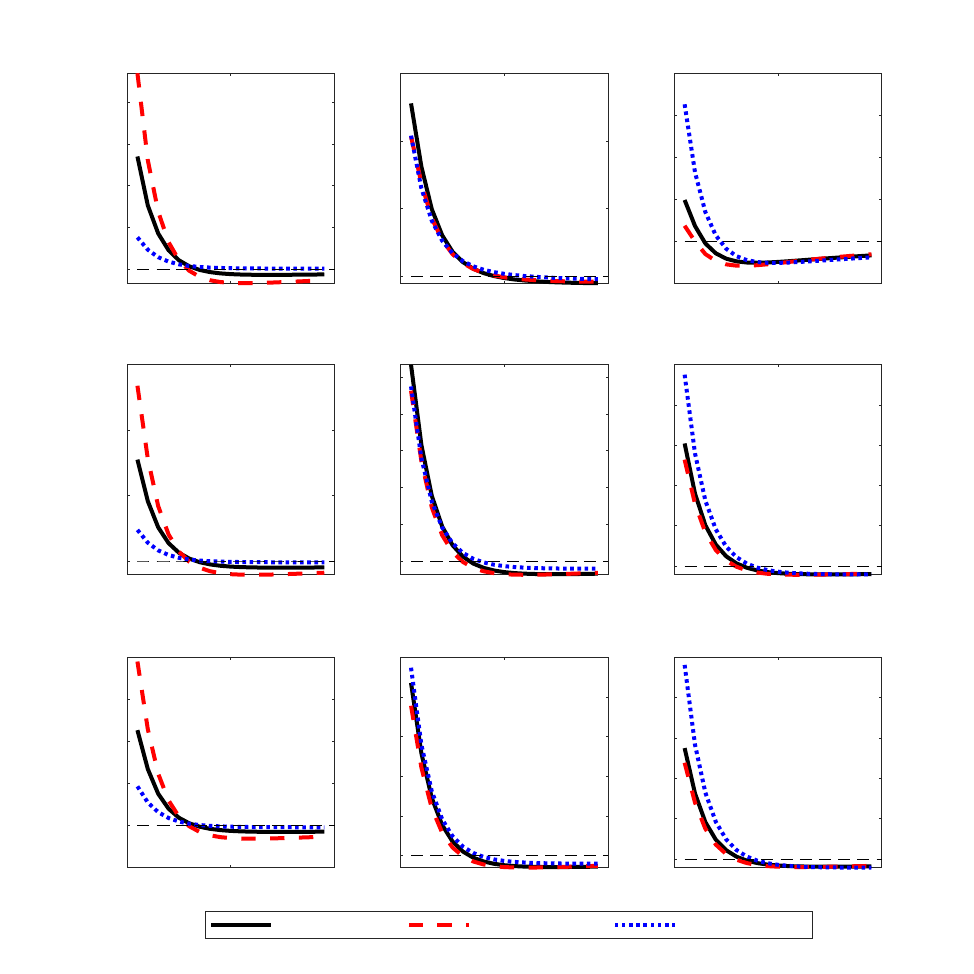
Figure 6: Effectiveness of monetary policy by groups (2)
0 10 20
0
0.5
1
1.5
2
Labour income
Poor
0 10 20
0
0.2
0.4
0.6
Middle
0 10 20
-0.1
0
0.1
0.2
0.3
0.4
Rich
0 10 20
0
2
4
6
Tightness
0 10 20
0
0.2
0.4
0.6
0.8
1
0 10 20
0
0.2
0.4
0.6
0.8
1
0 10 20
-0.1
0
0.1
0.2
0.3
0.4
Prob.-worker
0 10 20
0
0.02
0.04
0.06
0.08
0.1
0 10 20
0
0.02
0.04
0.06
0.08
0.1
Poor less volatile Poor more volatile All equally volatile
Notes: All variables are reported in percent deviations from the steady state, except probabilities,
which are in percentage points. Units on the horizontal axis are quarters.
4.1.1 The role of wage rigidity
The results shown above are, in addition to the friction due to market incompleteness, driven
by the interaction of two frictions, wage rigidities and search frictions. This subsection ex-
plains the role of wage rigidity in generating the amplification after a monetary expansion.
To do so, we re-run the monetary policy shock in calibration to Germany, but this time with
fully flexible wages. The aggregate results are reported in Figure 7, and the results for groups
by educational attainment in Figures 8 to 9. The red dashed line shows the benchmark results
reported above, while the dotted black line shows the case with fully flexible wages.
ECB Working Paper Series No 2850
30
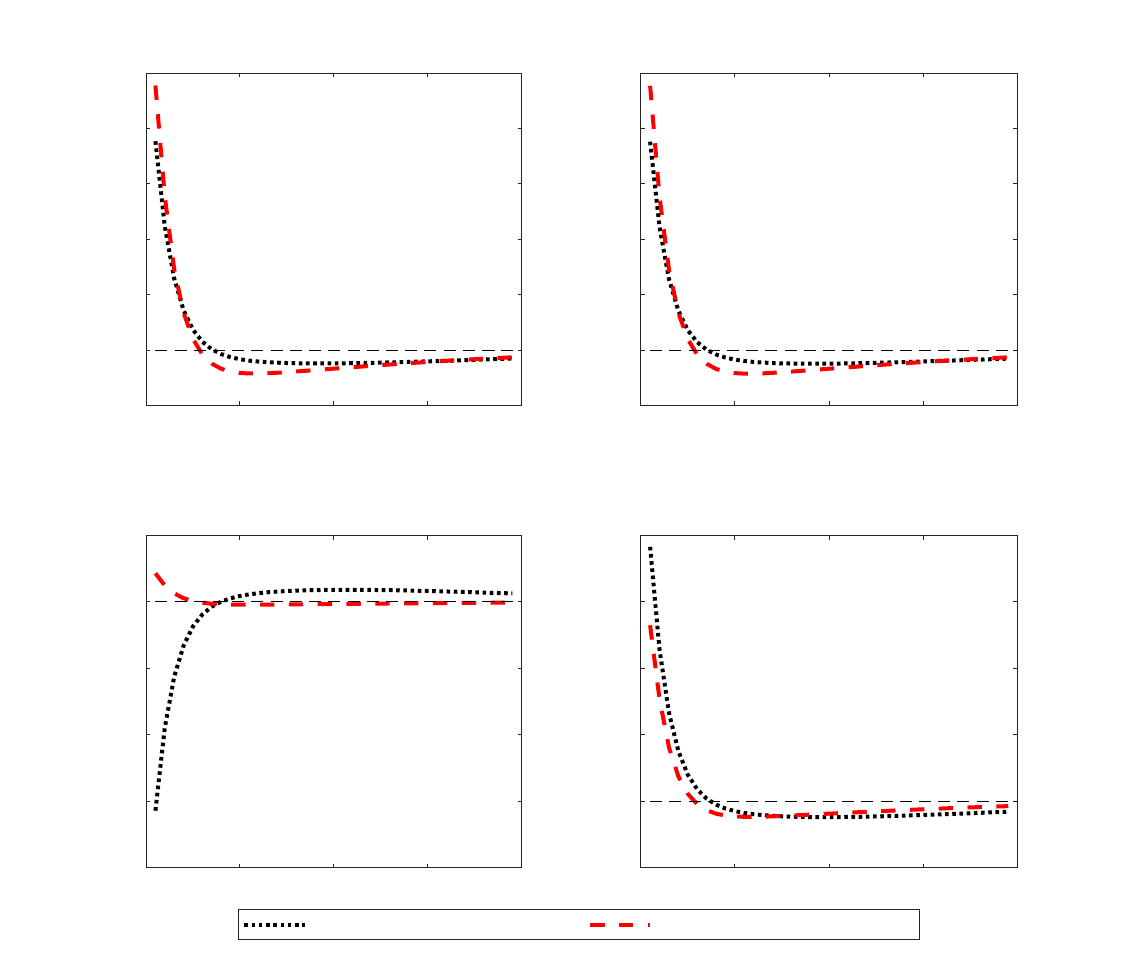
If we first turn to Figure 7, we see that after a monetary expansion, the aggregate labour
income increases by more when wages are fully flexible, but aggregate output and labour
increase by less, and dividends fall (note that the latter is a standard result in New Keynesian
models with sticky prices and flexible wages).
Figure 7: The role of wage rigidity - aggregate
0 10 20 30 40
-0.1
0
0.1
0.2
0.3
0.4
0.5
Output (Consumption)
0 10 20 30 40
-0.1
0
0.1
0.2
0.3
0.4
0.5
Labour
0 10 20 30 40
-2
-1.5
-1
-0.5
0
0.5
Dividends
0 10 20 30 40
-0.2
0
0.2
0.4
0.6
0.8
Total labour income (pre-tax)
Poor more volatile, flexible wages Poor more volatile, sticky wages
Notes: All variables are reported in percent deviations from the steady state. Units on the horizontal
axis are quarters.
ECB Working Paper Series No 2850
31
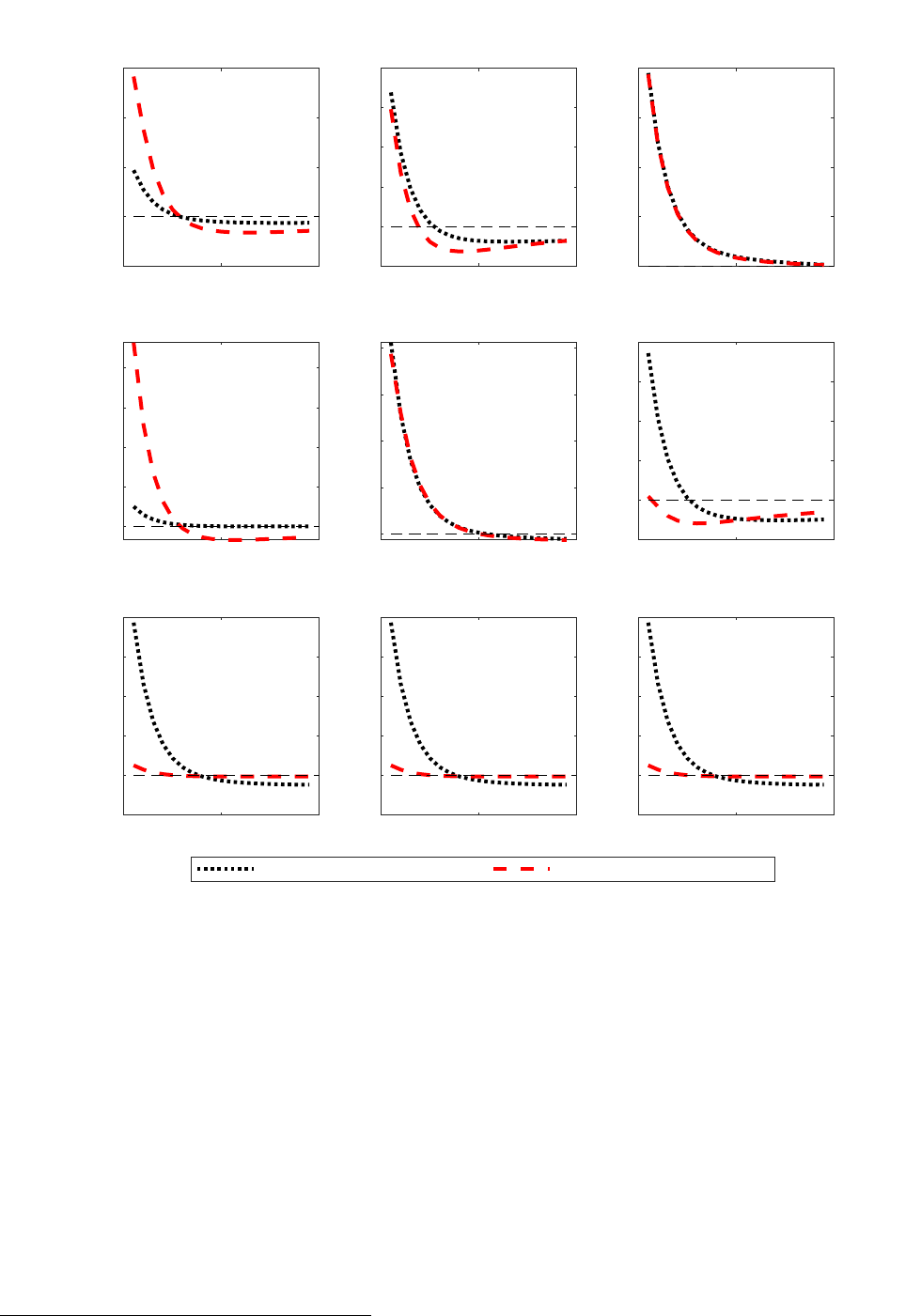
Figure 8: The role of wage rigidity by groups (1)
0 10 20
-0.5
0
0.5
1
1.5
Consumption
Poor
0 10 20
-0.1
0
0.1
0.2
0.3
0.4
Middle
0 10 20
0
0.1
0.2
0.3
0.4
Rich
0 10 20
0
0.5
1
1.5
2
Labour
0 10 20
0
0.1
0.2
0.3
0.4
0 10 20
-0.1
0
0.1
0.2
0.3
0.4
0 10 20
-0.1
0
0.1
0.2
0.3
0.4
Wages
0 10 20
-0.1
0
0.1
0.2
0.3
0.4
0 10 20
-0.1
0
0.1
0.2
0.3
0.4
Poor more volatile, flexible wages Poor more volatile, sticky wages
Notes: All variables are reported in percent deviations from the steady state. Units on the horizontal
axis are quarters.
The explanation for the result can be found by looking at Figures 8 and 9, where we see
that with flexible wages, most of the difference in the labour response is concentrated in the
segments of poor and rich workers, with the poor working less in the case of flexible wages
and the rich working more (both compared to the sticky wage case). Part of the reason is that
the rich households receive dividends, which fall in the case of flexible wages, increasing the
labour supply of these households. A more important reason is that with flexible wages, the
surplus of labour firms is less responsive for the poor compared to the benchmark case, and
given our calibration, it is also equally responsive across all labour market segments.
28
As a
28
Recall that this is because we calibrate vacancy posting costs in proportion to labour productivities of
ECB Working Paper Series No 2850
32
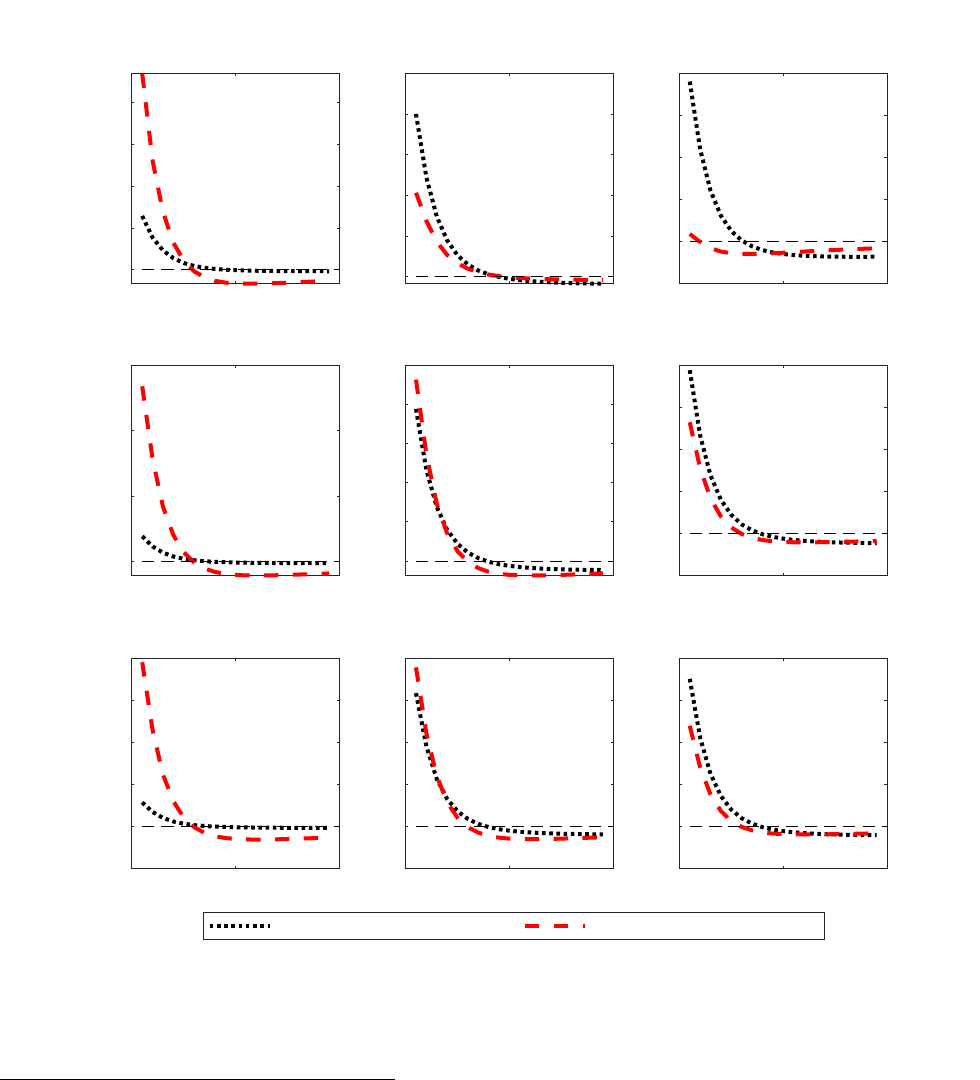
result, labour market tightness in Figure 9 increases approximately equally across all labour
market segments and is not disproportionally tilted towards the poor as in the benchmark
case. Compared to the sticky wage case, more jobs go towards the rich and middle-income
households, who have lower MPCs, so that the increase in aggregate demand, output, and
employment is lower. The amplification effect due to disproportionate hiring in the poor
labour market segment is also not as strong as in the benchmark case. Dividends fall because
a higher wage increase is required to induce workers to supply more labour.
Figure 9: The role of wage rigidity by groups (2)
0 10 20
0
0.5
1
1.5
2
Labour income
Poor
0 10 20
0
0.2
0.4
0.6
0.8
1
Middle
0 10 20
-0.2
0
0.2
0.4
0.6
0.8
Rich
0 10 20
0
2
4
6
Tightness
0 10 20
0
0.2
0.4
0.6
0.8
1
0 10 20
-0.2
0
0.2
0.4
0.6
0.8
0 10 20
-0.1
0
0.1
0.2
0.3
0.4
Prob.-worker
0 10 20
-0.02
0
0.02
0.04
0.06
0.08
0 10 20
-0.02
0
0.02
0.04
0.06
0.08
Poor more volatile, flexible wages Poor more volatile, sticky wages
Notes: All variables are reported in percent deviations from the steady state, except probabilities,
which are in percentage points. Units on the horizontal axis are quarters.
households.
ECB Working Paper Series No 2850
33

4.2 Calibration for the US and differentials in wage rigidities
So far, we have always assumed that wage rigidity is the same for all labour market segments,
i.e., we have not relied on differences in wage rigidities across labour market segments. This
is because we have little hard evidence for European countries that some labour market seg-
ments have more rigid wages than the others, although this may be the case due to different
degrees of unionisation. However, we do have some evidence of differences in wage rigidity
in the US, and this section looks into the effects of such differences.
First, recall that the evidence for the US reported in Figure 3 that suggests that wages
are more sticky in the labour market for workers with low educational attainment. This is
important in our model because differences in wage rigidity affect the volatility of a labour
firm’s surplus and, therefore, vacancy posting. To investigate this issue, we recalibrate the
model again, this time to the US (see Table 11), and conduct the following experiments. First,
we consider fully flexible wages across all labour market segments. Second, we make all
wages equally rigid. Third, we make rigid only wages of the labour market segment for the
poor.
29
Table 11: Matching function and labour firms, US calibration
Parameter Poor Middle Rich
Vacancy posting cost (fraction of lab. end.) ψ
z
h
0.06 0.05 0.04
Matching efficiency ϕ
z
h
0.6 0.6 0.6
Entrepreneur’s share α
z
h
0.02 0.05 0.10
Wage rigidity, flexible ω
R
0 0 0
Wage rigidity, rigid poor ω
R
0.5 0 0
Wage rigidity, all rigid ω
R
0.5 0.5 0.5
Job finding probability p
W
0.60 0.70 0.80
We repeat the simulation of an expansionary and persistent monetary policy shock
across the three experiments. First, we consider the flexible-wage case, which is shown in
Figures 10, 11 and 12 in full black lines. As one alternative, we assume wages are more rigid
in the labour market segment of the less educated (and therefore poorer) households. This
setup implies that in response to an expansionary monetary policy shock, labour firms post
more vacancies in lower-paying segments with more rigid wages because firm profits in this
segment increase by more. Figure 10 shows the result of this experiment in dashed blue lines.
Finally, we consider the case where all groups have equally rigid wages, which is shown in
red dashed lines. Figures 11 and 12 show the effects by groups of households (each column
is one group of households by their labour productivity).
Our main result is that if wages of the poor are rigid, so that they obtain more jobs, then
output increases by more than it does when all wages are flexible, and also more than in the
29
Because of high job finding probabilities in the US and because we use a Cobb-Douglas matching function,
it could happen that matching probability exceeds 1 if the shock is large. During the computation, we impose
the restriction that if this happens, the matching probability is set to 1.
ECB Working Paper Series No 2850
34

case where all wages are equally rigid. The difference is not negligible, given that the strength
of the output response on impact when wages of the poor are rigid is about 0.5%, compared
to about 0.4% in the flexible-wage and the rigid-wage cases. This is even more so given that
the group of poor households is relatively small in the model (25% of the population).
Figure 10: Effectiveness of monetary policy depending on who gets jobs
0 10 20 30 40
-0.1
0
0.1
0.2
0.3
0.4
0.5
Output (Consumption)
0 10 20 30 40
-0.1
0
0.1
0.2
0.3
0.4
0.5
Labour
0 10 20 30 40
-1.5
-1
-0.5
0
Dividends
0 10 20 30 40
-0.2
0
0.2
0.4
0.6
0.8
Total labour income (pre-tax)
Poor less volatile Poor more volatile All equally volatile
Notes: All variables are reported in percent deviations from the steady state. Units on the horizontal
axis are quarters.
The mechanism that gives rise to this result is similar to the ones discussed above for
European countries, just that here the strong increase in labour firm surplus in the poor
labour market segment is amplified by the interaction both lower entrepreneur’s share and
higher wage stickiness in the labour market segment for the poor (dashed blue lines). Note
that this result is not obvious, because more rigid wages for the poor also mean less wage-
ECB Working Paper Series No 2850
35
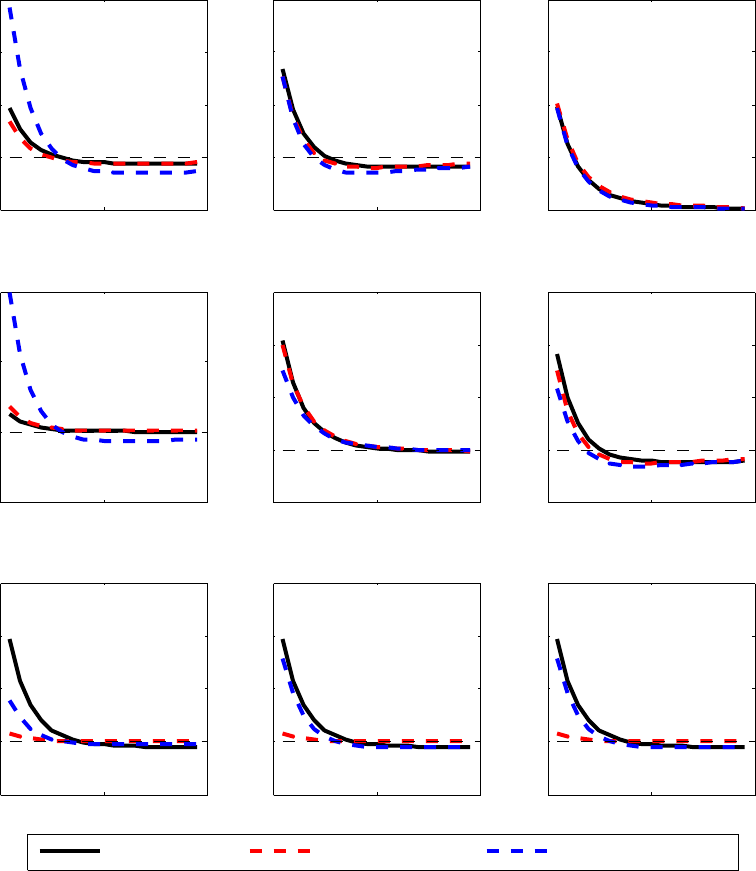
increase-related income. It is therefore crucial that in the case of more rigid wages of the poor
the increase in employment is strong enough to dominate the lower increase in wages. Note
also that the wealth effect on labour supply also works against the amplification. However,
because the supply of searchers also depends on matching probability (and not only on
wages), the reduction in the number of searchers due to the wealth effect is not strong enough
to undo the effects of higher labour demand.
Figure 11: Effectiveness of monetary policy by groups (1)
0 10 20
−0.5
0
0.5
1
1.5
Consumption
Poor
0 10 20
−0.2
0
0.2
0.4
0.6
Middle
0 10 20
0
0.2
0.4
0.6
0.8
Rich
0 10 20
−1
0
1
2
Labour
0 10 20
−0.2
0
0.2
0.4
0.6
0 10 20
−0.2
0
0.2
0.4
0.6
0 10 20
−0.2
0
0.2
0.4
0.6
Wages
0 10 20
−0.2
0
0.2
0.4
0.6
0 10 20
−0.2
0
0.2
0.4
0.6
Flexible wages Sticky wages − all Sticky wages − poor
Notes: All variables are reported in percent deviations from the steady state. Units on the horizontal
axis are quarters.
ECB Working Paper Series No 2850
36
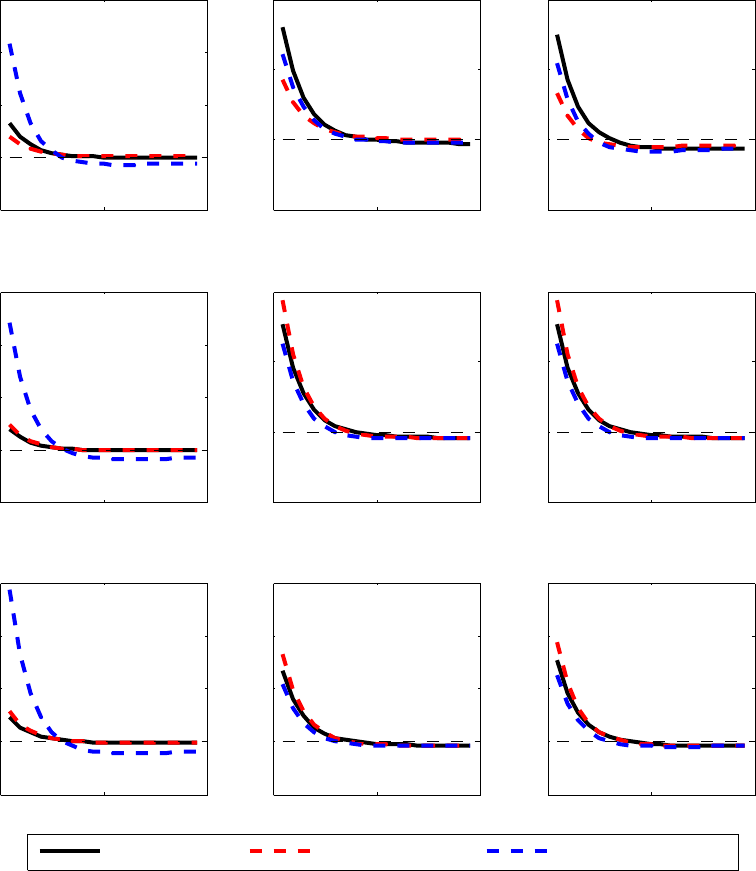
Figure 12: Effectiveness of monetary policy by groups (2)
0 10 20
−1
0
1
2
3
Labour income
Poor
0 10 20
−0.5
0
0.5
1
Middle
0 10 20
−0.5
0
0.5
1
Rich
0 10 20
−2
0
2
4
6
Tightness
0 10 20
−0.5
0
0.5
1
0 10 20
−0.5
0
0.5
1
0 10 20
−0.5
0
0.5
1
1.5
Prob.−worker
0 10 20
−0.2
0
0.2
0.4
0.6
0 10 20
−0.2
0
0.2
0.4
0.6
Flexible wages Sticky wages − all Sticky wages − poor
Notes: All variables are reported in percent deviations from the steady state. Units on the horizontal
axis are quarters.
ECB Working Paper Series No 2850
37
5 Conclusion
This paper first documents several empirical characteristics of the labour market across ed-
ucational attainment levels. We find that in several large European countries labour market
at low educational attainment levels is typically more precarious, with lower job finding
rates than those for high educational attainment. Moreover, job finding rates for low ed-
ucational attainment are typically also more volatile and more procyclical, which indicates
higher labour income risk in this segment of the labour market. At cyclical frequencies, fluc-
tuations in job finding rates explain the majority of cyclical fluctuations in unemployment
at the lower educational attainment levels, and the share of explained fluctuations can ex-
ceed 80% in countries such as Germany and France. Cyclical fluctuations in separation rates
tend to be less important in explaining fluctuations in unemployment, especially at lower
educational attainment levels. The situation is similar in the US.
We then construct a stylised incomplete markets model with the search-and-matching
framework for segmented labour markets for workers with different educational attainment.
We calibrate the model to capture the characteristics that are in line with the empirical find-
ings for Germany, Spain, and the US. We then use the differences to illustrate the transmission
channels of standard monetary policy in the model, and extend the analysis to forward guid-
ance.
Our main finding is that the effectiveness of monetary policy on consumption and output
is amplified if less educated and hence poorer households tend to obtain relatively more jobs
than more educated and richer households after a monetary stimulus. This result is only in
part due to the fact that poor households have the largest marginal propensities to consume.
There is also a general-equilibrium effect from higher aggregate consumption and output that
leads to more labour demand. When labour markets of the poor are more cyclical, this leads
to more hiring in these segments, which amplifies the income and consumption of the poor
households and hence aggregate consumption. There may be several reasons that amplify
this transmission channel, either higher wage rigidity in the labour market segment for the
poor, or lower and hence more volatile profits for hiring a worker from a less skilled labour
market segment, or both.
ECB Working Paper Series No 2850
38
References
(2016): “The Household Finance and Consumption Survey: results from the second wave,”
ECB Statistics Paper 18, Frankfurt a. M.
Acharya, S. and K. Dogra (2018): “Understanding HANK: insights from a PRANK,” Staff
Reports 835, Federal Reserve Bank of New York.
Adrjan, P. (2019): “What Next for British Steel Employees?” blog entry.
Amberg, N., T. Jansson, M. Klein, and A. R. Picco (2022): “Five Facts about the Distribu-
tional Income Effects of Monetary Policy Shocks,” American Economic Review: Insights, 4,
289–304.
Auclert, A. (2019): “Monetary policy and the redistribution channel,” American Economic
Review, 109, 2333–67.
Auclert, A. and M. Rognlie (2018): “Inequality and Aggregate Demand,” Working Paper
24280, National Bureau of Economic Research.
Bilbiie, F. (2018): “Monetary Policy and Heterogeneity: An Analytical Framework,” CEPR
Discussion Papers 12601, C.E.P.R. Discussion Papers.
Broer, T., N.-J. H. Hansen, P. Krusell, and E.
¨
Oberg (2018): “The New Keynesian Trans-
mission Mechanism: A Heterogeneous-Agent Perspective,” .
Broer, T., J. Kramer, and K. Mitman (2022): “The Curious Incidence of Monetary Policy
Shocks Across the Income Distribution,” Sveriges Riksbank Working Paper, 416.
Daly, M. C., B. Hobijn, and T. S. Wiles (2012): “Dissecting aggregate real wage fluctua-
tions: Individual wage growth and the composition effect,” Federal Reserve Bank of San
Francisco.
Den Haan, W. J., P. Rendahl, and M. Riegler (2017): “Unemployment (fears) and defla-
tionary spirals,” Journal of the European Economic Association, 16, 1281–1349.
Den Haan, W. J. and P. Sedlacek (2014): “Inefficient continuation decisions, job creation
costs, and the cost of business cycles,” Quantitative Economics, 5, 297–349.
Dolado, J. J., G. Motyovszki, and E. Pappa (2021): “Monetary policy and inequality un-
der labor market frictions and capital-skill complementarity,” American Economic Journal:
Macroeconomics, 13, 292–332.
Doniger, C. L. (2019): “Do Greasy Wheels Curb Inequality?” Finance and Economics Dis-
cussion Series 2019-021, Board of Governors of the Federal Reserve System (US).
Dossche, M. and J. Hartwig (2019): “Household Income Risk over the Business Cycle,”
Economic Bulletin, 6, 58–65.
ECB Working Paper Series No 2850
39
Elsby, M. W., B. Hobijn, and A. Sahin (2010): “The Labor Market in the Great Recession,”
Working Paper 15979, National Bureau of Economic Research.
Elsby, M. W., B. Hobijn, and A. S¸ahin (2013): “Unemployment dynamics in the OECD,”
Review of Economics and Statistics, 95, 530–548.
Elsby, M. W., B. Hobijn, and A. S¸ahin (2015): “On the importance of the participation
margin for labor market fluctuations,” Journal of Monetary Economics, 72, 64 – 82.
Floden, M. and J. Lind
´
e (2001): “Idiosyncratic risk in the United States and Sweden: Is there
a role for government insurance?” Review of Economic dynamics, 4, 406–437.
Fujita, S. and G. Ramey (2009): “The cyclicality of separationa nd job finding rates,” Interna-
tional Economic Review, 50, 415–430.
Gornemann, N., K. Kuester, and M. Nakajima (2016): “Doves for the rich, hawks for the
poor? Distributional consequences of monetary policy,” .
Guvenen, F., S. Schulhofer-Wohl, J. Song, and M. Yogo (2017): “Worker Betas: Five Facts
about Systematic Earnings Risk,” American Economic Review, 107, 398–403.
Haefke, C., M. Sonntag, and T. van Rens (2013): “Wage rigidity and job creation,” Journal
of Monetary Economics, 60, 887 – 899.
Hagedorn, M., J. Luo, I. Manovskii, and K. Mitman (2018): “Forward Guidance,” Working
Paper 24521, National Bureau of Economic Research.
Hagedorn, M. and I. Manovskii (2008): “The cyclical behavior of equilibrium unemploy-
ment and vacancies revisited,” American Economic Review, 98, 1692–1706.
Hall, R. E. (2005): “Employment fluctuations with equilibrium wage stickiness,” American
Economic Review, 95, 50–65.
Haltiwanger, J., H. Hyatt, and E. McEntarfer (2018): “Who Moves Up the Job Ladder?”
Journal of Labor Economics, 36, S301 – S336.
Hoynes, H., D. L. Miller, and J. Schaller (2012): “Who Suffers during Recessions?” Journal
of Economic Perspectives, 26, 27–48.
Kaplan, G., B. Moll, and G. L. Violante (2018): “Monetary Policy According to HANK,”
American Economic Review, 108, 697–743.
Kramer, J. (2022): “The Cyclicality of Earnings Growth along the Distribution-Causes and
Consequences,” mimeo.
Kudlyak, M. (2014): “The cyclicality of the user cost of labor,” Journal of Monetary Economics,
68, 53 – 67.
ECB Working Paper Series No 2850
40
Lenza, M. and J. Slacalek (2018): “How does monetary policy affect income and wealth
inequality? Evidence from quantitative easing in the euro area,” Working Paper Series
2190, European Central Bank.
McKay, A., E. Nakamura, and J. Steinsson (2016): “The Power of Forward Guidance Re-
visited,” American Economic Review, 106, 3133–58.
McKay, A. and R. Reis (2016): “The Role of Automatic Stabilizers in the U.S. Business Cycle,”
Econometrica, 84, 141–194.
Mueller, A. I. (2017): “Separations, Sorting, and Cyclical Unemployment,” American Eco-
nomic Review, 107, 2081–2107.
Patterson, C. (2023): “The Matching Multiplier and the Amplification of Recessions,” Amer-
ican Economic Review, 113, 982–1012.
Petrongolo, B. and C. A. Pissarides (2001): “Looking into the black box: A survey of the
matching function,” Journal of Economic Literature, 39, 390–431.
Ravn, M. O. and V. Sterk (2016): “Macroeconomic Fluctuations with HANK & SAM: An
Analytical Approach,” Discussion Papers 1633, Centre for Macroeconomics (CFM).
——— (2017): “Job uncertainty and deep recessions,” Journal of Monetary Economics, 90, 125–
141.
Shimer, R. (2005): “The cyclical behavior of equilibrium unemployment and vacancies,”
American Economic Review, 95, 25–49.
——— (2012): “Reassessing the ins and outs of unemployment,” Review of Economic Dynamics,
15, 127–148.
Slacalek, J., O. Tristani, and G. L. Violante (2020): “Household balance sheet channels of
monetary policy: A back of the envelope calculation for the Euro Area,” Journal of Economic
Dynamics and Control, 115, 103879.
Werning, I. (2015): “Incomplete Markets and Aggregate Demand,” Working Paper 21448,
National Bureau of Economic Research.
ECB Working Paper Series No 2850
41
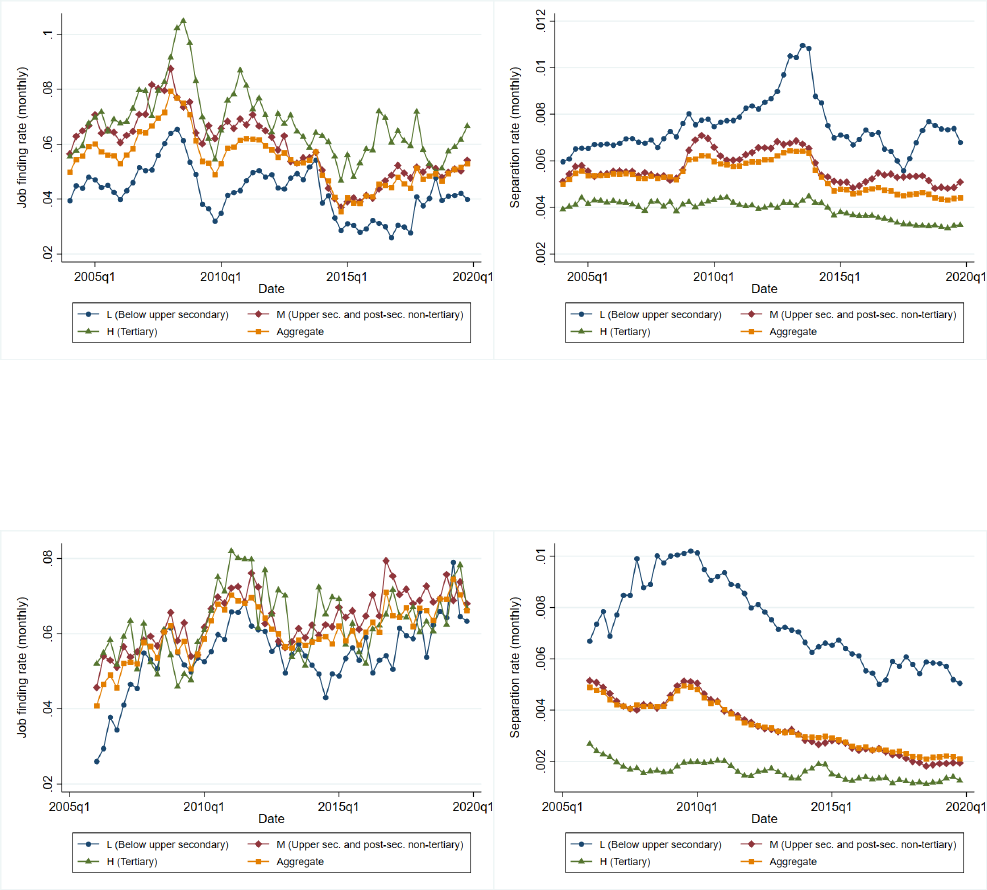
A Additional empirical evidence from European countries
A.1 Job finding rates and separation rates by educational attainment in
Europe
A.1.1 Unemployment duration spell less than 3 months (d<3)
Figure 13: France
Figure 14: Germany
ECB Working Paper Series No 2850
42

Figure 15: Greece
Figure 16: Italy
ECB Working Paper Series No 2850
43
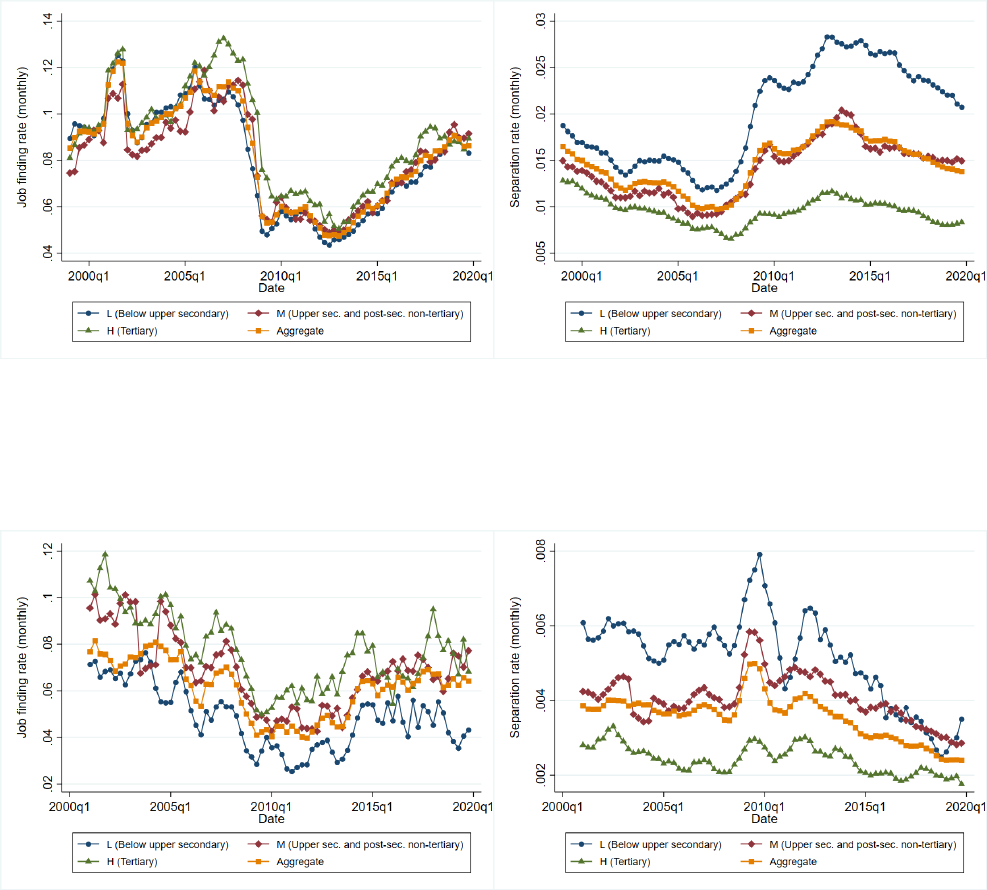
Figure 17: Spain
Figure 18: UK
ECB Working Paper Series No 2850
44
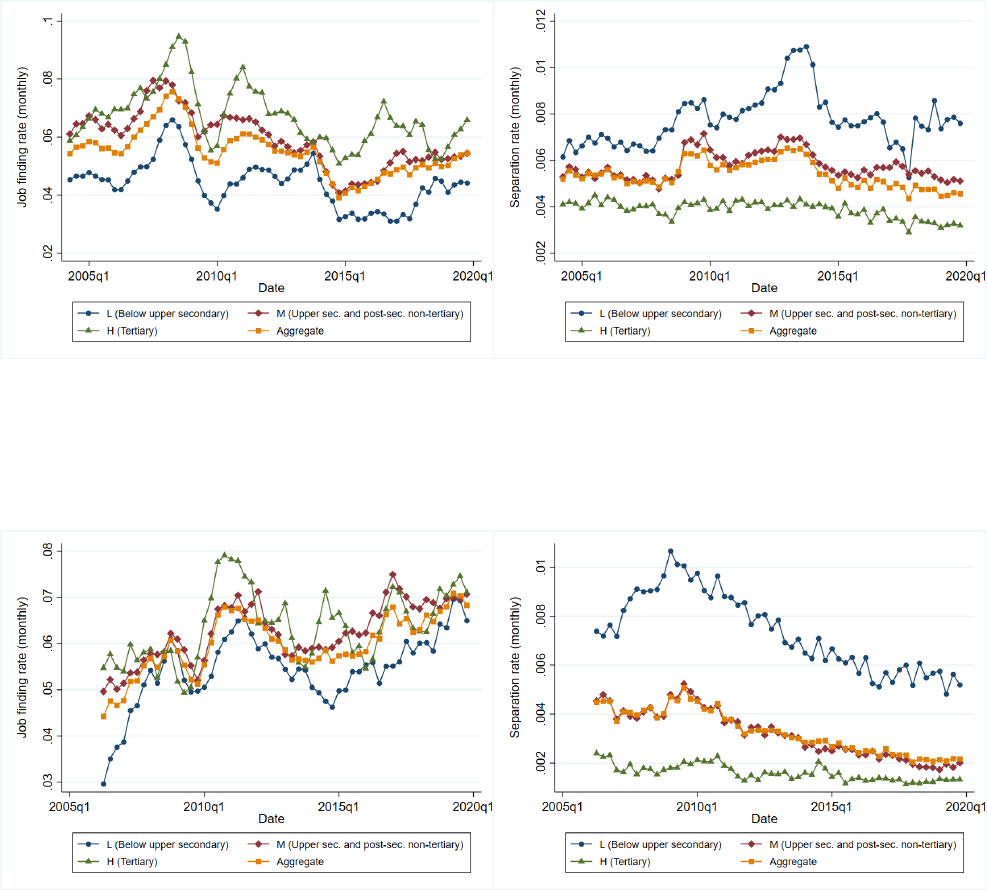
A.1.2 Unemployment duration spell less than 6 months (d<6)
Figure 19: France
Figure 20: Germany
ECB Working Paper Series No 2850
45
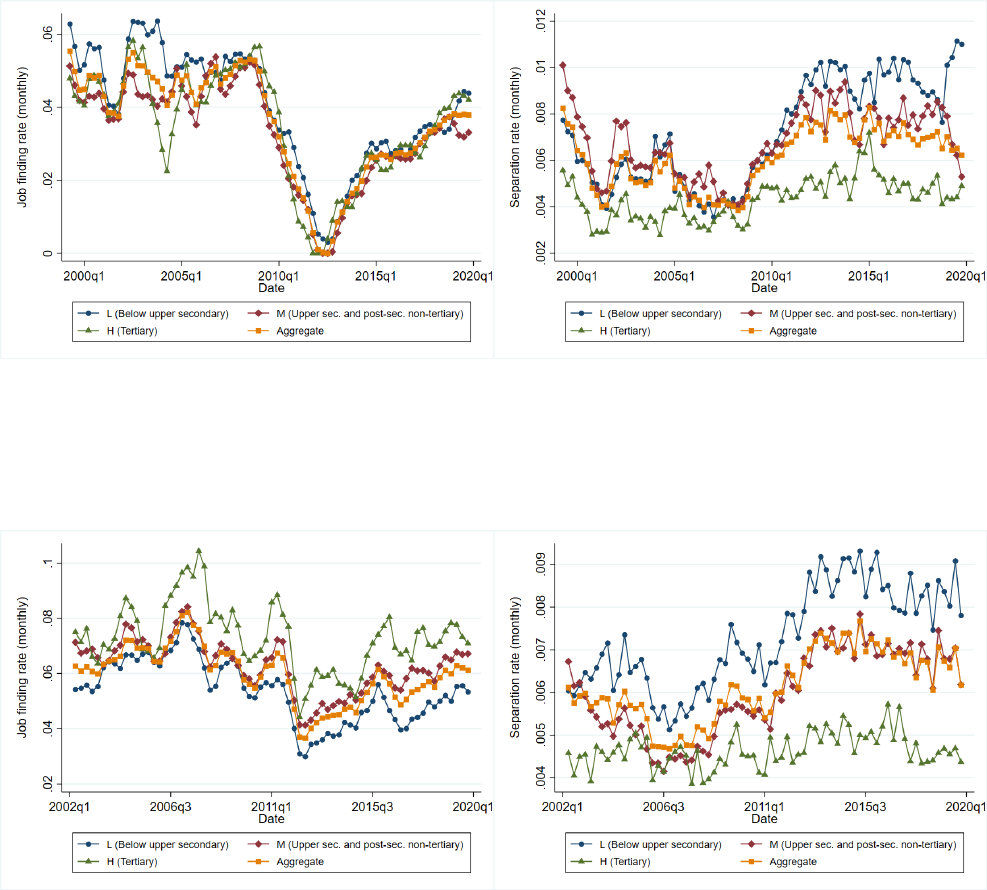
Figure 21: Greece
Figure 22: Italy
ECB Working Paper Series No 2850
46
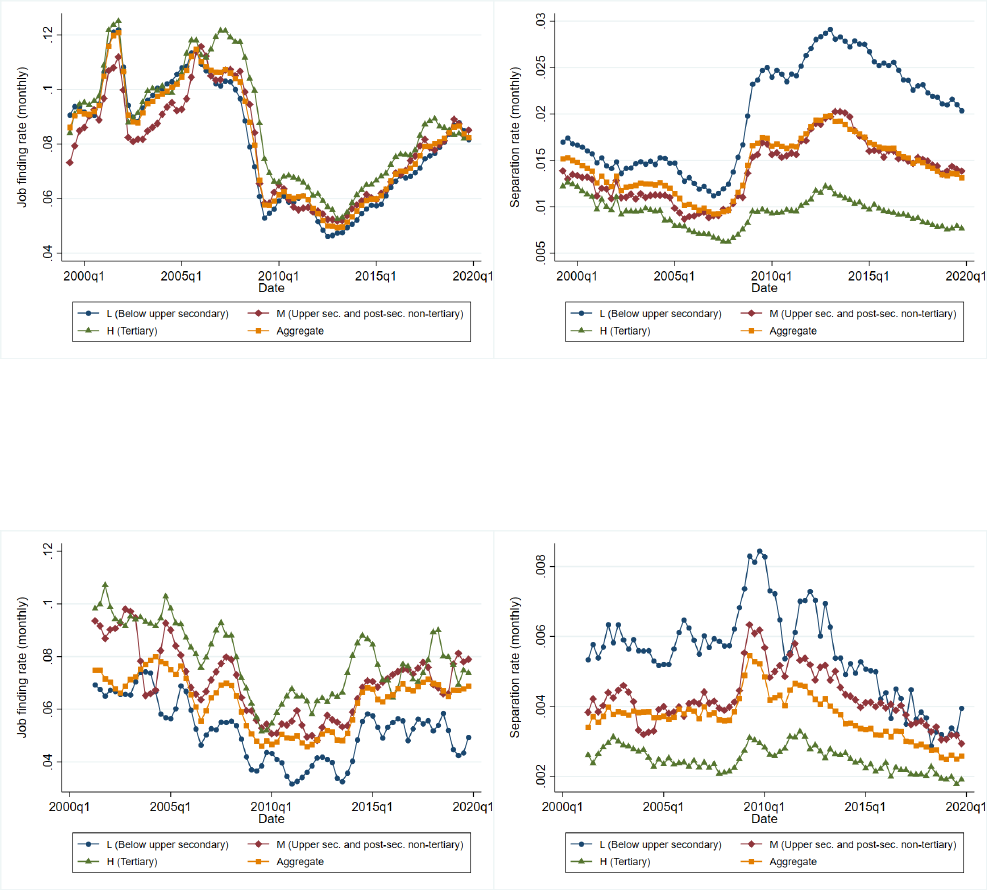
Figure 23: Spain
Figure 24: UK
ECB Working Paper Series No 2850
47
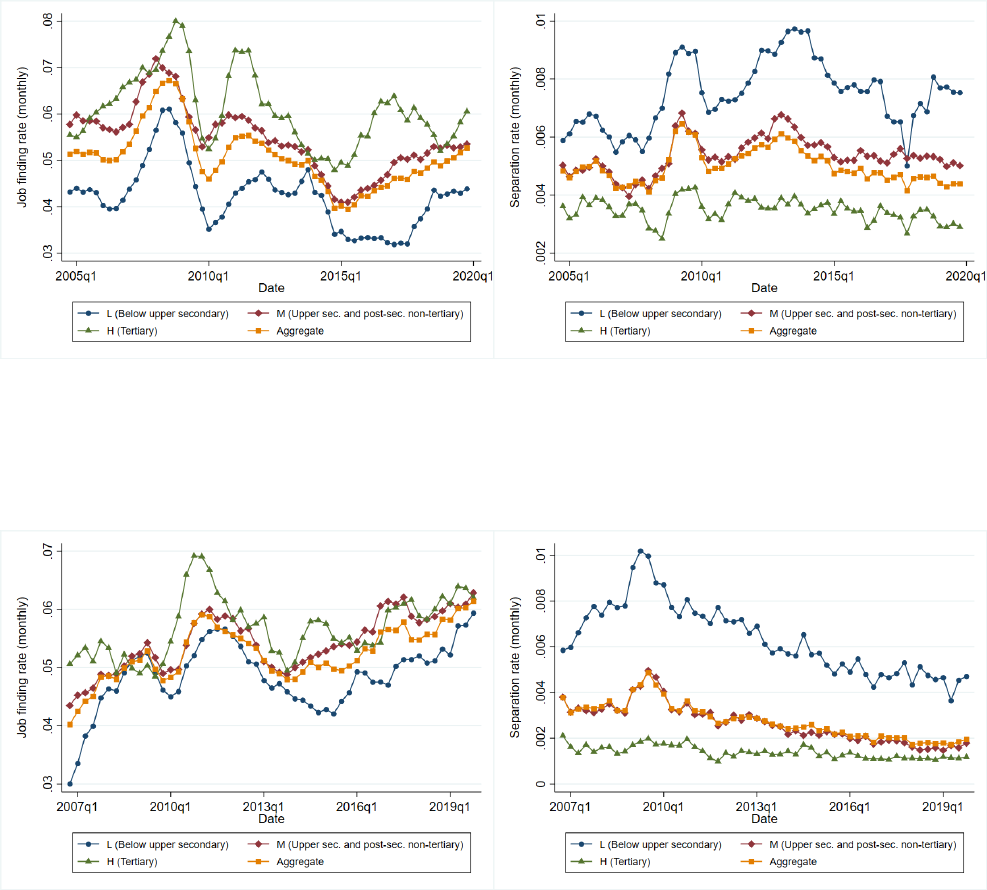
A.1.3 Unemployment duration spell less than 12 months (d<12)
Figure 25: France
Figure 26: Germany
ECB Working Paper Series No 2850
48
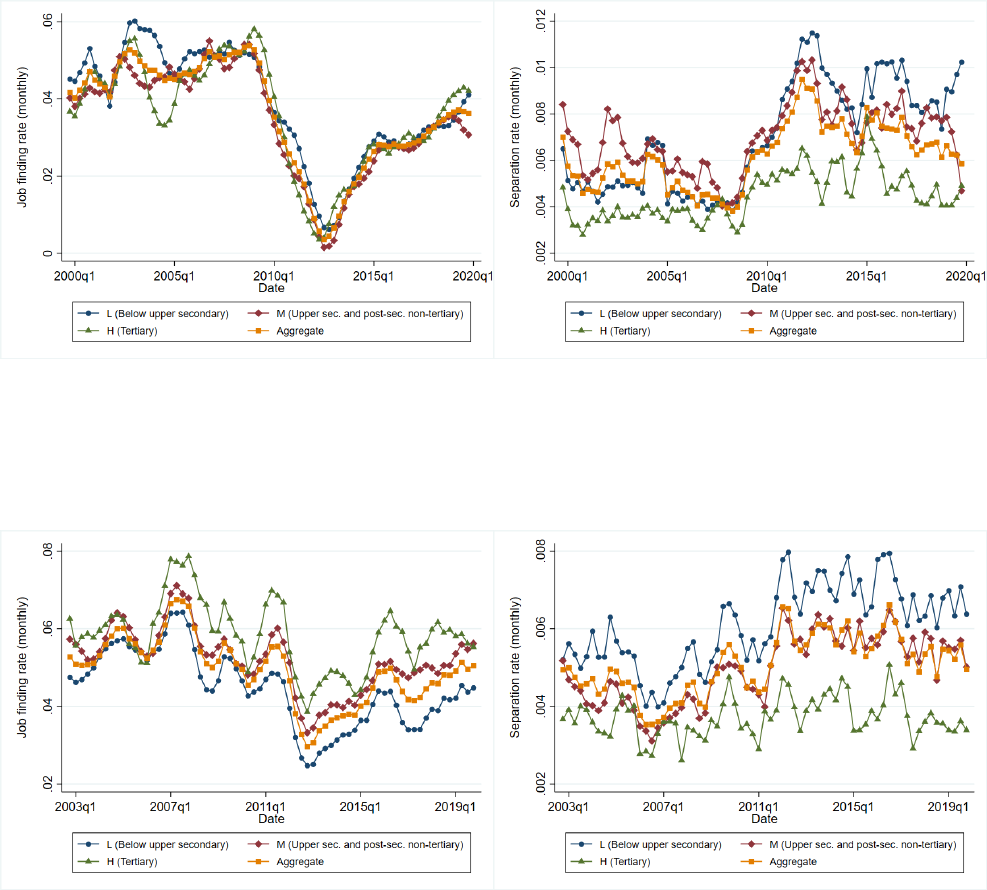
Figure 27: Greece
Figure 28: Italy
ECB Working Paper Series No 2850
49
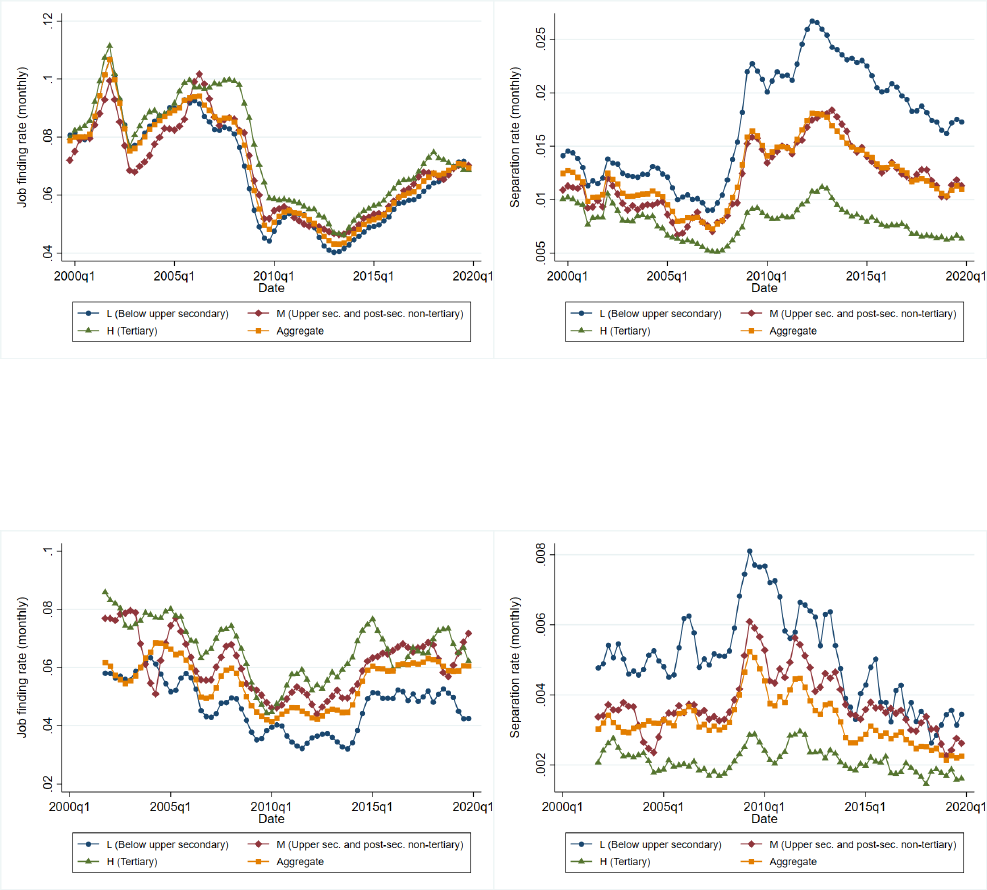
Figure 29: Spain
Figure 30: UK
ECB Working Paper Series No 2850
50

A.2 Job finding probabilities and separation probabilities across Euro-
pean countries
While the main text reports monthly job finding rates to be consistent with the literature
(e.g., Fujita and Ramey (2009), Shimer (2012)), it is sometimes convenient to have quarterly
probabilities, in particular, when calibrating models that are typically at a quarterly frequency.
This appendix reports the companion set of business cycle statistics in terms of quarterly
probabilities.
30
Table 12: Quarterly job finding probabilities
F
<3
F
<6
F
<12
Country Sample L M H L M H L M H
France 2003Q1-2019Q4 0.12 0.16 0.18 0.12 0.16 0.18 0.12 0.15 0.17
Germany 2005Q1-2019Q4 0.15 0.17 0.17 0.15 0.17 0.17 0.14 0.15 0.16
Greece 1998Q1-2019Q4 0.09 0.08 0.09 0.11 0.10 0.10 0.11 0.10 0.10
Italy 2001Q1-2019Q4 0.15 0.17 0.21 0.15 0.17 0.20 0.13 0.15 0.16
Spain 1998Q1-2019Q4 0.22 0.22 0.23 0.21 0.21 0.23 0.18 0.19 0.20
UK 2000Q1-2019Q4 0.14 0.19 0.21 0.15 0.19 0.21 0.13 0.18 0.18
Notes: The table reports quarterly job finding probabilities associated with the estimated monthly job finding
rates f
t
, computed as F
t
= 1 − e
−3 f
t
, where F
t
is the probability that an unemployed worker finds a job in
the next quarter. L = Less than primary, primary, and lower secondary education, M = Upper secondary and
post-secondary non-tertiary education, and H = Tertiary education. Values are sample averages. We end the
sample in Q4 2019 to exclude the COVID-19 period.
Table 13: Quarterly separation probabilities
S
<3
S
<6
S
<12
Country Sample L
M H L M H L M H
France 2003Q1-2019Q4 0.020 0.017
0.012 0.021 0.017 0.012 0.020 0.016 0.011
Germany 2005Q1-2019Q4 0.021 0.010 0.005 0.021 0.010 0.005 0.018 0.008 0.004
Greece 1998Q1-2019Q4 0.015 0.017 0.012 0.019 0.021 0.014 0.018 0.021 0.014
Italy 2001Q1-2019Q4 0.021 0.018 0.015 0.021 0.018 0.015 0.018 0.015 0.012
Spain 1998Q1-2019Q4 0.057 0.042 0.029 0.057 0.042 0.029 0.049 0.036 0.025
UK 2000Q1-2019Q4 0.015 0.012 0.008 0.016 0.013 0.008 0.014 0.011 0.007
Notes: The table reports quarterly separation probabilities associated with the estimated monthly separation
rates s
t
, computed as S
t
= 1 − e
−3s
t
, where S
t
is the probability that an employed worker loses a job in the
quarter. L = Less than primary, primary, and lower secondary education, M = Upper secondary and post-
secondary non-tertiary education, and H = Tertiary education. Values are sample averages. We end the sample
in Q4 2019 to exclude the COVID-19 period.
30
While quantitatively not important, note that the transformation from monthly rates to quarterly probabili-
ties is nonlinear. If x is rate and X is probability, the formula is X = 1 − e
−3x
.
ECB Working Paper Series No 2850
51

Table 14: Cyclical properties of job finding probabilities, quarterly
Rel.
own v
ol. Rel. aggregate vol. Corr. with agg.
σ(F
i
)/σ(U
i
) σ(F
i
)/σ(U) unemployment
Countr
y Sample L
M H L M H L M H
France
2003Q1-2019Q4 36.54 28.35
34.13 39.25 29.42 45.72 -0.60 -0.43 -0.55
Germany 2005Q1-2019Q4 42.06 31.02 39.72 40.40 34.50 56.94 -0.46 -0.20 -0.07
Greece 1998Q1-2019Q4 22.23 16.55 25.22 21.31 17.79 26.71 -0.40 -0.43 -0.42
Italy 2001Q1-2019Q4 29.32 30.17 39.44 30.47 29.97 45.36 -0.23 -0.41 -0.49
Spain 1998Q1-2019Q4 19.64 24.11 24.22 20.93 22.66 24.13 -0.61 -0.71 -0.81
UK 2000Q1-2019Q4 33.17 29.69 26.77 29.56 33.31 36.80 -0.33 -0.44 -0.30
Notes: The table reports standard deviations of cyclical components of quarterly job finding probabilities,
computed as F
t
= 1 − e
−3 f
t
, relative to the standard deviation of the cyclical component of each group’s un-
employment U
i
, aggregate unemployment U, and correlations of cyclical components of quarterly job finding
probabilities with the cyclical component of aggregate unemployment, all based on d = 3 estimates. L = Less
than primary, primary, and lower secondary education, M = Upper secondary and post-secondary non-tertiary
education, and H = Tertiary education. We end the sample in Q4 2019 to exclude the COVID-19 period.
Table 15: Cyclical properties of separation probabilities, quarterly
Rel. own vol. Rel. aggregate vol. Corr. with agg.
σ(S
i
)/σ(U
i
) σ(S
i
)/σ(U) unemployment
Country Sample L M H L M H L M H
France 2003Q1-2019Q4 3.00 2.43 0.86 3.22 2.53 1.15 -0.07 0.09 0.31
Germany 2005Q1-2019Q4 4.31 2.20 0.95 4.14 2.45 1.36 0.01 0.65 0.52
Greece 1998Q1-2019Q4 2.09 2.67 1.72 2.00 2.88 1.83 0.31 0.25 0.10
Italy 2001Q1-2019Q4 1.91 1.52 1.31 1.98 1.51 1.50 0.67 0.60 0.39
Spain 1998Q1-2019Q4 3.63 2.68 1.47 3.87 2.52 1.46 0.83 0.81 0.81
UK 2000Q1-2019Q4 2.40 1.48 0.82 2.14 1.66 1.13 0.23 0.47 0.66
Notes: The table reports standard deviations of cyclical components of quarterly separation probabilities, com-
puted as S
t
= 1 − e
−3s
t
, relative to the standard deviation of the cyclical component of each group’s unemploy-
ment U
i
, aggregate unemployment U, and correlations of cyclical components of quarterly separation prob-
abilities with the cyclical component of aggregate unemployment, all based on d = 3 estimates. L = Less
than primary, primary, and lower secondary education, M = Upper secondary and post-secondary non-tertiary
education, and H = Tertiary education. We end the sample in Q4 2019 to exclude the COVID-19 period.
ECB Working Paper Series No 2850
52
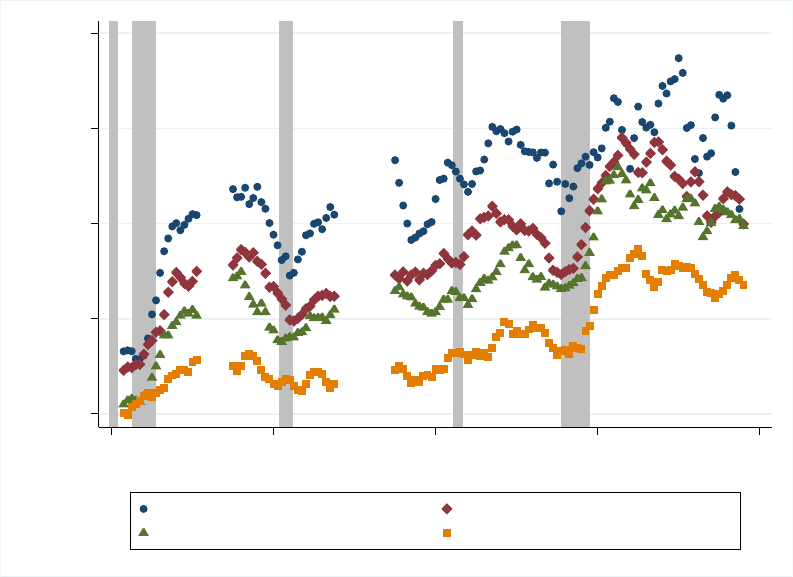
B Additional empirical evidence from the US
B.1 Wage rigidity in the US
Figure 31: Wage rigidity by educational attainment – Full sample
5 10 15 20 25
Nominal wage rigidity
1980q1 1990q1 2000q1 2010q1 2020q1
date
Less than high school High school or equivalent, no college
Some college or Associate degree Bachelor’s or advanced degree
Notes: Percentage of workers who saw no change in their wage over the past year by educational attainment.
Source: https://www.frbsf.org/economic-research/indicators-data/nominal-wage-rigidity/
ECB Working Paper Series No 2850
53

B.2 Alternative measures of a business cycle
Table 16: Worker flows over business cycle
(1)
(2) (3)
Net hir
es Hires Separations
NBER
recession -0.013*** -0.015***
-0.004
(0.001) (0.002) (0.003)
Less than high school 0.001*** 0.030*** 0.029***
(0.000) (0.001) (0.001)
High school or equivalent, no college -0.001*** 0.011*** 0.012***
(0.000) (0.000) (0.000)
Some college or Associate degree -0.000 0.006*** 0.006***
(0.000) (0.000) (0.000)
Less than high school × NBER recession -0.007*** 0.002* 0.008***
(0.001) (0.001) (0.001)
High school or equivalent, no college × NBER recession -0.003*** -0.000 0.003***
(0.001) (0.001) (0.001)
Some college or Associate degree × NBER recession -0.002** -0.000 0.001*
(0.001) (0.001) (0.001)
T
ime FE X X
X
Observations 272 276 276
R-squared 0.929 0.971 0.954
Robust
standard err
ors in parentheses
*** p<0.01, ** p<0.05, * p<0.1
Notes: (Net) hires and separations are rates and are expressed as a share of average employment within the
education group. NBER recession is a dummy variable indicating NBER recessions.
ECB Working Paper Series No 2850
54

Table 17: Worker flows over the business cycle
(1)
(2) (3)
Net hir
es Hires Separations
Less
than high school 0.000
0.030*** 0.030***
(0.000) (0.001) (0.001)
High school or equivalent, no college -0.001*** 0.011*** 0.012***
(0.000) (0.000) (0.000)
Some college or Associate degree -0.001** 0.006*** 0.007***
(0.000) (0.000) (0.000)
Less than high school × UE cycle -0.007** -0.006* 0.001
(0.003) (0.003) (0.005)
High school or equivalent, no college × UE cycle -0.004** -0.000 0.004
(0.002) (0.002) (0.002)
Some college or Associate degree × UE cycle -0.002 0.000 0.003
(0.002) (0.002) (0.002)
T
ime FE X X
X
Observations 272 276 276
R-squared 0.895 0.971 0.947
Robust
standard err
ors in parentheses
*** p<0.01, ** p<0.05, * p<0.1
Notes: (Net) hires and separations are rates and are expressed as a share of an average employment within
the education group. UE cycle is the cyclical component of unemployment level within the educational group,
obtained by the Hodrick-Prescott Filter using logarithm of seasonally adjusted unemployment level.
ECB Working Paper Series No 2850
55

B.3 Sensitivity of flows to changes in the GDP
To estimate the sensitivity of changes in (net) hires and separation rates to changes in the
GDP across education groups, we estimate the following specification:
∆Y
i,t
= γ
t
+ θ
1
educ
i
+ θ
2
educ
i
× ∆lnGDP
t
+ ϵ
i,t
, (37)
where ∆Y
i,t
is the change in either (net) hire or separation rate, educ
i
is workers’ educational
attainment, ∆lnGDP
t
is the change in the logarithm of GDP, γ
t
are time dummies to control
for common shocks, and ϵ
i,t
is the residual term.
Table 18: Sensitivity of worker flows to changes in GDP
(1) (2) (3)
∆ Net hires ∆ Hir
es ∆ Separations
Less than high school -0.0007*
-0.0007*** -0.0001
(0.0003) (0.0003) (0.0002)
High school or equivalent, no college -0.0003 -0.0002 0.0000
(0.0003) (0.0002) (0.0002)
Some college or Associate degree -0.0002 -0.0001 0.0001
(0.0003) (0.0002) (0.0002)
Less than high school * ∆ ln GDP 0.1505*** 0.0937** -0.0542*
(0.0431) (0.0370) (0.0312)
High school or equivalent, no college * ∆ ln GDP 0.0767** 0.0429* -0.0309
(0.0305) (0.0227) (0.0252)
Some college or Associate degree * ∆ ln GDP 0.0489 0.0210 -0.0264
(0.0329) (0.0279) (0.0245)
Time FE X X X
Obser
vations 268 272 272
R-squared 0.8720 0.8017 0.8673
Robust standard err
ors in parentheses
*** p<0.01, ** p<0.05, * p<0.1
ECB Working Paper Series No 2850
56

C The remaining model equations
This section describes the remaining model equations. The description closely follows McKay
et al. (2016).
Final goods and intermediate goods. Final goods Y
t
are produced by bundling intermedi-
ate goods y
j,t
, using
Y
t
=
Z
1
0
y
1
µ
j,t
dj
µ
(38)
Intermediate goods are produced by a continuum of mass 1 of intermediate goods firms
indexed by j according to the following technology:
y
j,t
= n
j,t
, (39)
where n
j,t
is the amount of labour services hired by the intermediate goods firm j. The final
good is produced by a representative competitive firm, but intermediate goods are produced
by monopolistically competitive firms. These firms are subject to pricing frictions and can
update their prices only with a probability θ per period. The optimisation of the final goods
producer implies
y
j,t
=
p
j,t
P
t
µ
1−µ
Y
t
, (40)
where p
j,t
is the price charged by firm j at time t and P
t
is the aggregate price level, given by
P
t
=
Z
1
0
p
1
1−µ
j,t
dj
1−µ
. (41)
The intermediate producer solves the following problem:
max
p
∗
t
,{y
j,s
,n
j,s
}
∞
s=t
∞
∑
s=t
β
s−t
(1 − θ)
s−t
p
∗
t
P
s
y
j,s
− W
s
n
j,s
, (42)
subject to 39 and 40. The solution to this problem is
p
∗
t
P
t
=
∑
∞
s=t
β
s−t
(1 − θ)
s−t
p
∗
t
P
s
µ
1−µ
Y
s
µW
s
∑
∞
s=t
β
s−t
(1 − θ)
s−t
p
∗
t
P
s
µ
1−µ
Y
s
. (43)
Government. The government runs a balanced budget, using taxes levied based on (exoge-
nous) labour productivity only to pay interest on otherwise constant bond stock,
B
1 + r
t
+
∑
z
Γ
z
(z)τ
t
τ(z) = B (44)
The relation between nominal rate, real rate, and inflation is
ECB Working Paper Series No 2850
57

1 + r
t
=
1 + i
t
1 + π
t+1
. (45)
Equilibrium. In equilibrium, if Γ
t
(b, z) is the distribution of households asset holdings b
over the idiosyncratic state z at time t, that satisfies
Γ
t+1
B, z
′
=
Z
{(b,z):g
t
(b,z)∈B}
Pr
z
′
|z
dΓ
t
(b, z), (46)
where g
t
(b, z) is the decision rule for household’s savings.
Labour supply by households through labour firms has to be equal to labour demand by
intermediate goods firms:
L
t
≡
Z
z
h,t
l
h,t
(b, z)dΓ
t
(b, z), (47)
where the aggregation is across household types and their labour supply (note that l
h,t
de-
pends both on household’s wealth and the matching probabilities across labour market seg-
ments). Labour market clearing implies
L
t
= N
t
. (48)
Aggregate production is
N
t
≡
Z
n
j,t
dj = Y
t
S
t
, (49)
where S
t
is price dispersion due to nominal rigidities, defined as
S
t
≡
Z
1
0
p
j,t
P
t
dj (50)
with the law of motion
S
t+1
= (1 − θ)S
t
(1 + π
t+1
)
−µ
1−µ
+ θ
p
∗
t+1
P
t+1
µ
1−µ
. (51)
Inflation can be defined as
1 + π
t
=
1 − θ
1 − θ
p
∗
t
P
t
1
1−µ
1−µ
. (52)
In addition, labour markets clear, bond markets clear, and goods markets clear (taking into
account that dividends are D
t
= Y
t
− W
t
N
t
)
B =
Z
g
t
(b, z)dΓ
t
(b, z), (53)
ECB Working Paper Series No 2850
58
Y
t
= C
t
. (54)
In equilibrium, all decision rules, value functions satisfy all optimality conditions, definitions,
and budget constraints.
ECB Working Paper Series No 2850
59
D Forward guidance and labour market volatility
D.1 European countries
For completeness, this appendix reports the implications of higher volatility on the labour
market for the poor on the effectiveness of forward guidance. We simulate forward guidance
as a fully credible announcement of a one-time interest rate decrease in period 10. The results
are reported in Figures 32 to 34, again for two cases: the red dashed line show our benchmark
case, where labour market for the poor is very volatile, and the full black lines show the case
where this volatility is smaller (but still higher than in the segments for the middle-income
and rich households).
ECB Working Paper Series No 2850
60
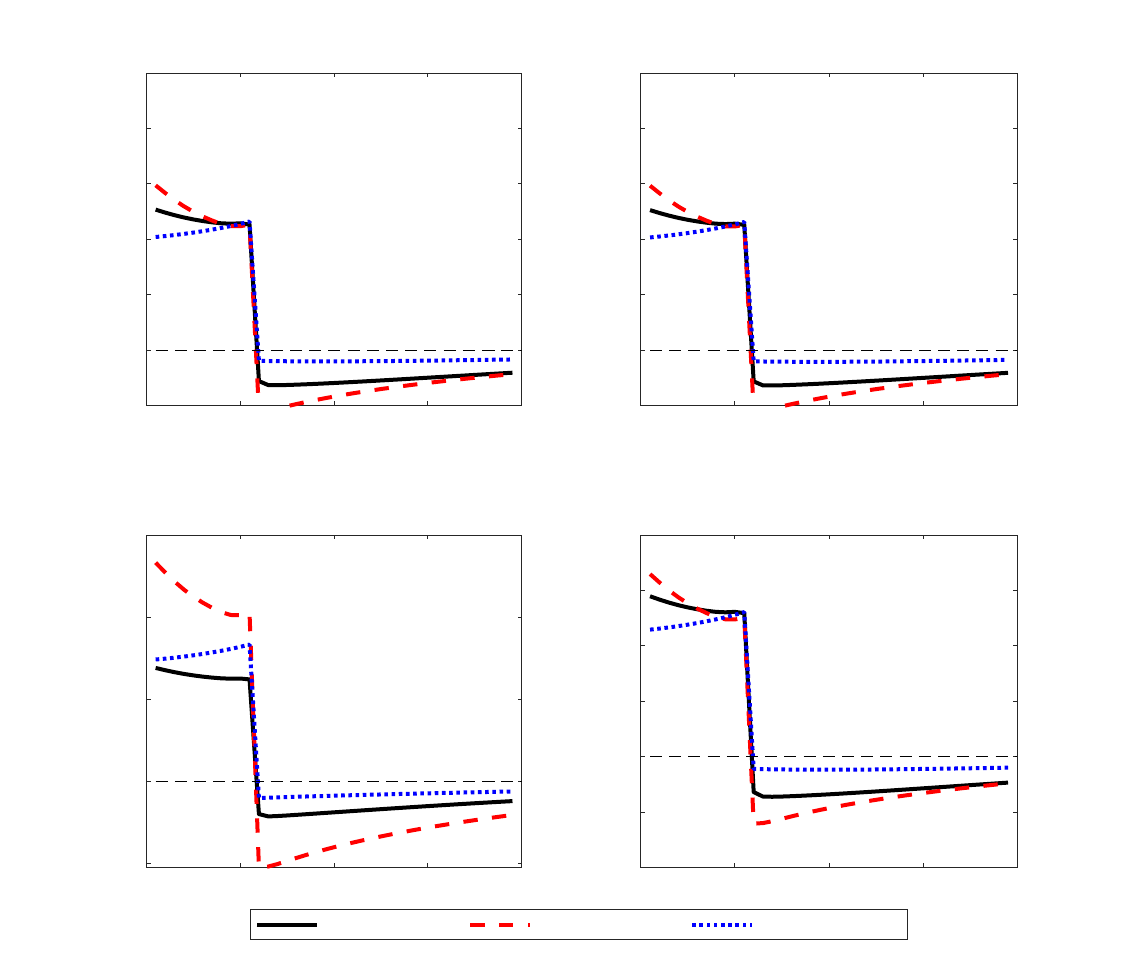
Figure 32: Effectiveness of forward guidance depending on who gets jobs
0 10 20 30 40
-0.1
0
0.1
0.2
0.3
0.4
0.5
Output (Consumption)
0 10 20 30 40
-0.1
0
0.1
0.2
0.3
0.4
0.5
Labour
0 10 20 30 40
-0.05
0
0.05
0.1
0.15
Dividends
0 10 20 30 40
-0.2
-0.1
0
0.1
0.2
0.3
0.4
Total labour income (pre-tax)
Poor less volatile Poor more volatile All equally volatile
Notes: All variables are reported in percent deviations from the steady state. Units on the horizontal
axis are quarters.
ECB Working Paper Series No 2850
61
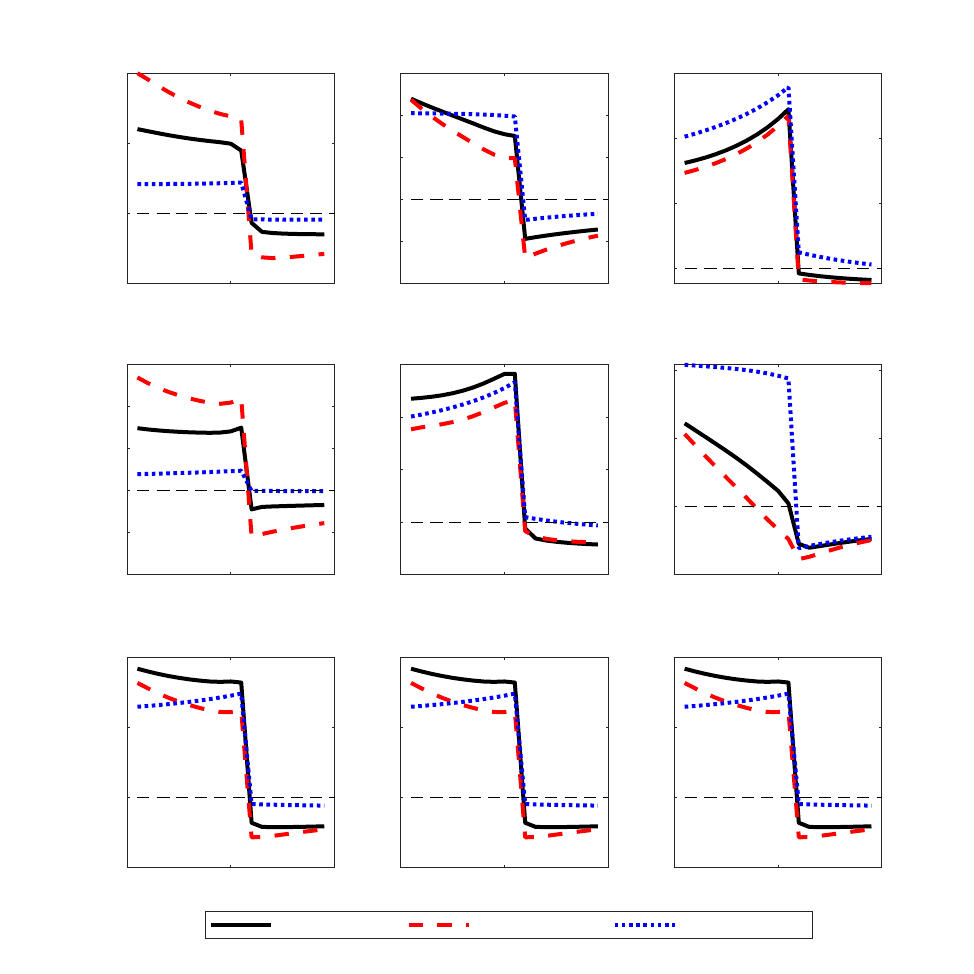
Figure 33: Effectiveness of forward guidance by groups (1)
0 10 20
-0.5
0
0.5
1
Consumption
Poor
0 10 20
-0.2
-0.1
0
0.1
0.2
0.3
Middle
0 10 20
0
0.1
0.2
0.3
Rich
0 10 20
-1
-0.5
0
0.5
1
1.5
Labour
0 10 20
-0.1
0
0.1
0.2
0.3
0 10 20
-0.1
0
0.1
0.2
0 10 20
-0.01
0
0.01
0.02
Wages
0 10 20
-0.01
0
0.01
0.02
0 10 20
-0.01
0
0.01
0.02
Poor less volatile Poor more volatile All equally volatile
Notes: All variables are reported in percent deviations from the steady state. Units on the horizontal
axis are quarters.
ECB Working Paper Series No 2850
62

Figure 34: Effectiveness of forward guidance by groups (2)
0 10 20
-1
-0.5
0
0.5
1
1.5
Labour income
Poor
0 10 20
-0.1
0
0.1
0.2
0.3
Middle
0 10 20
-0.1
0
0.1
0.2
Rich
0 10 20
-2
0
2
4
Tightness
0 10 20
-0.2
0
0.2
0.4
0.6
0 10 20
-0.2
0
0.2
0.4
0.6
0.8
0 10 20
-0.1
0
0.1
0.2
0.3
Prob.-worker
0 10 20
-0.02
0
0.02
0.04
0.06
0.08
0 10 20
-0.02
0
0.02
0.04
0.06
0.08
Poor less volatile Poor more volatile All equally volatile
Notes: All variables are reported in percent deviations from the steady state, except probabilities,
which are in percentage points. Units on the horizontal axis are quarters.
D.2 Calibration to the US
This section reports the implications of different wage stickiness across labour market seg-
ments for the effectiveness of forward guidance. Similarly to standard monetary policy in the
main text, the effectiveness of forward guidance depends on who obtains jobs. As shown in
Figures 35, 36, and 37, the amplification of the forward guidance ”puzzle” is mainly driven
by the poor obtaining jobs, i.e, the mechanisms at work are similar as for the standard mone-
tary policy shock described above. We obtain the amplification of the strength of the forward
ECB Working Paper Series No 2850
63
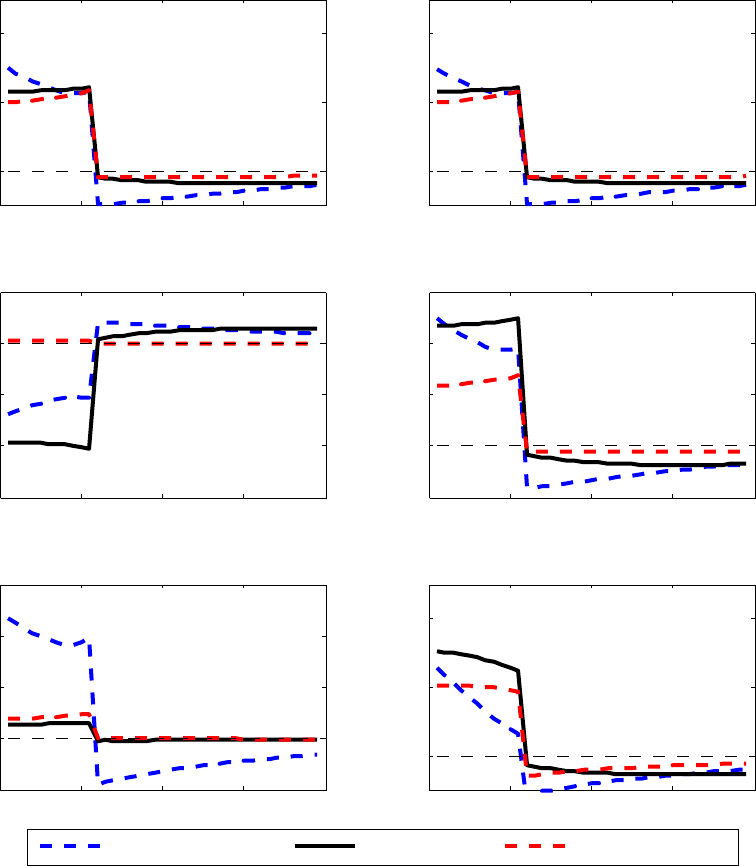
guidance only when the poor obtain jobs.
Figure 35: Forward guidance depending on who gets jobs
0 10 20 30 40
0
0.2
0.4
Output (Consumption)
0 10 20 30 40
0
0.2
0.4
Labour
0 10 20 30 40
−1.5
−1
−0.5
0
0.5
Dividends
0 10 20 30 40
−0.2
0
0.2
0.4
0.6
Total labour income (pre−tax)
0 10 20 30 40
−0.5
0
0.5
1
1.5
Labour by poor
0 10 20 30 40
0
0.2
0.4
Labour by rich
Sticky wages − poor Flexible wages Sticky wages − all
Notes: All variables are reported in percent deviations from the steady state. Units on the horizontal
axis are quarters.
ECB Working Paper Series No 2850
64
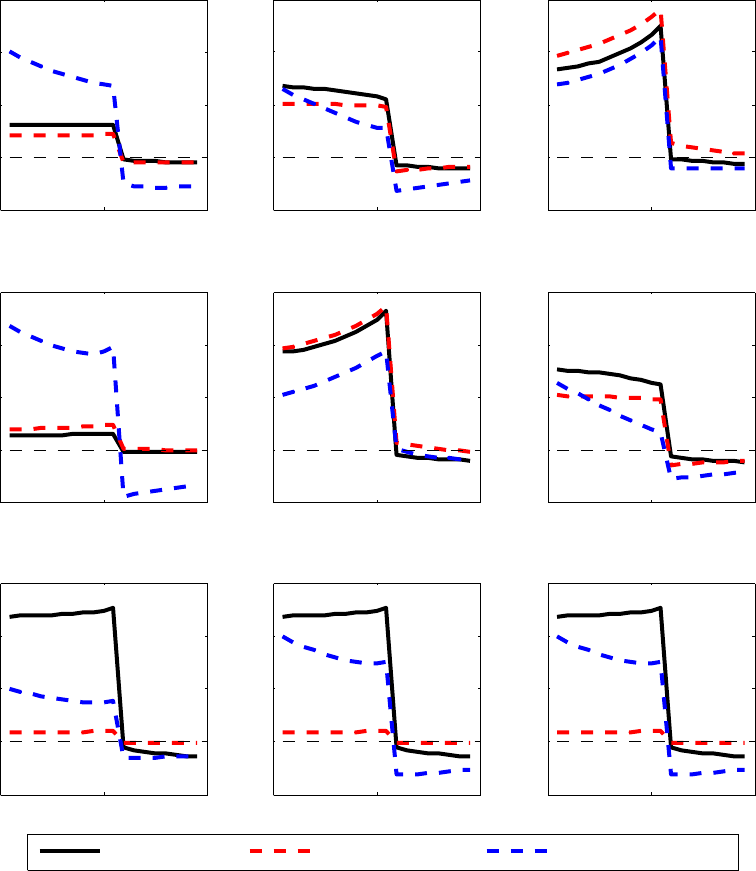
Figure 36: Forward guidance, by groups (1)
0 10 20
−0.5
0
0.5
1
1.5
Consumption
Poor
0 10 20
−0.2
0
0.2
0.4
0.6
Middle
0 10 20
−0.1
0
0.1
0.2
0.3
Rich
0 10 20
−0.5
0
0.5
1
1.5
Labour
0 10 20
−0.1
0
0.1
0.2
0.3
0 10 20
−0.2
0
0.2
0.4
0.6
0 10 20
−0.1
0
0.1
0.2
0.3
Wages
0 10 20
−0.1
0
0.1
0.2
0.3
0 10 20
−0.1
0
0.1
0.2
0.3
Flexible wages Sticky wages − all Sticky wages − poor
Notes: All variables are reported in percent deviations from the steady state. Units on the horizontal
axis are quarters.
ECB Working Paper Series No 2850
65
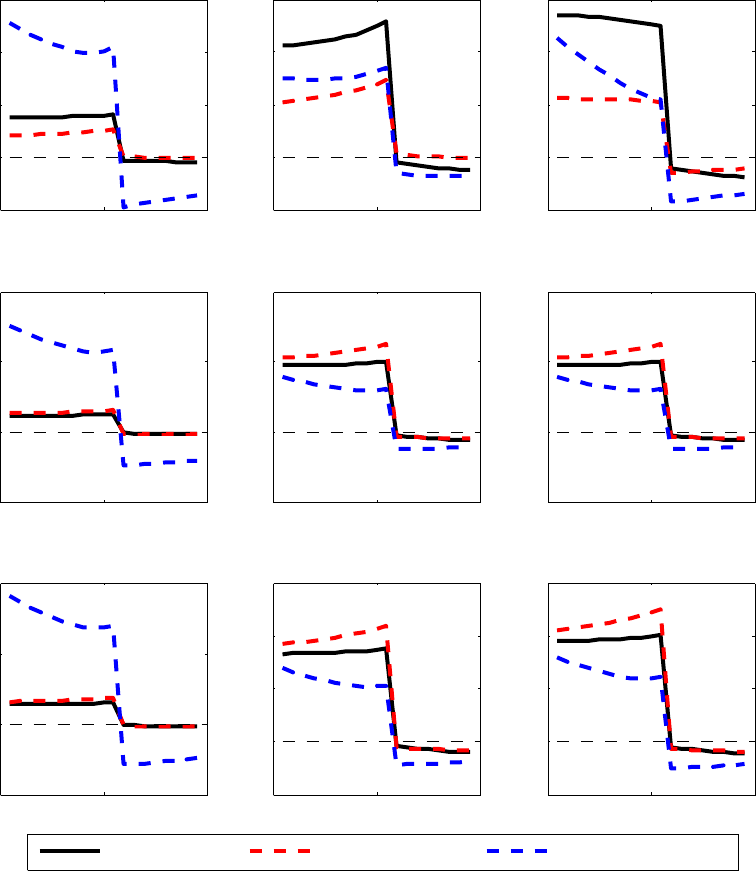
Figure 37: Forward guidance, by groups (2)
0 10 20
−0.5
0
0.5
1
1.5
Labour income
Poor
0 10 20
−0.2
0
0.2
0.4
0.6
Middle
0 10 20
−0.2
0
0.2
0.4
0.6
Rich
0 10 20
−2
0
2
4
Tightness
0 10 20
−0.5
0
0.5
1
0 10 20
−0.5
0
0.5
1
0 10 20
−0.5
0
0.5
1
Prob.−worker
0 10 20
−0.1
0
0.1
0.2
0.3
0 10 20
−0.1
0
0.1
0.2
0.3
Flexible wages Sticky wages − all Sticky wages − poor
Notes: All variables are reported in percent deviations from the steady state. Units on the horizontal
axis are quarters.
ECB Working Paper Series No 2850
66

Acknowledgements
We have benefited from conversations with Husnu Dalgic, Wouter den Haan, Francois Langot, Ralph Lütticke, Reamonn Lydon,
Benjamin Moll, Ricardo Reis, Petr Sedláček, Jirka Slačálek, Vincent Sterk, and Gianluca Violante. We are also grateful to seminar
participants in the 25th International CEF meeting, the Annual Workshop: ESCB Research Cluster 2 in Frankfurt, the conference on
Income Distribution, Wealth Distribution and Central Bank Policies in London (2020), 2020 Frankfurt – Mannheim Macro Workshop,
2020 Central Bank Macro Modelling Workshop, and RES 2021 Annual Conference.
The opinions expressed are those of the authors and do not reflect views of the European Central Bank or of the Eurosystem. Part of
this paper has been written while Matija was at the ECB. All errors are our own.
Uroš Herman
Aix Marseille University, CNRS, AMSE, Marseille, France; email: uros.herman@univ-amu.fr
Matija Lozej
Central Bank of Ireland, Dublin, Ireland; email: matija.lozej@centralbank.ie
© European Central Bank, 2023
Postal address 60640 Frankfurt am Main, Germany
Telephone +49 69 1344 0
Website www.ecb.europa.eu
All rights reserved. Any reproduction, publication and reprint in the form of a different publication, whether printed or produced
electronically, in whole or in part, is permitted only with the explicit written authorisation of the ECB or the authors.
This paper can be downloaded without charge from www.ecb.europa.eu, from the Social Science Research Network electronic library or
from RePEc: Research Papers in Economics. Information on all of the papers published in the ECB Working Paper Series can be found
on the ECB’s website.
PDF ISBN 978-92-899-6215-5 ISSN 1725-2806 doi:10.2866/325480 QB-AR-23-087-EN-N
